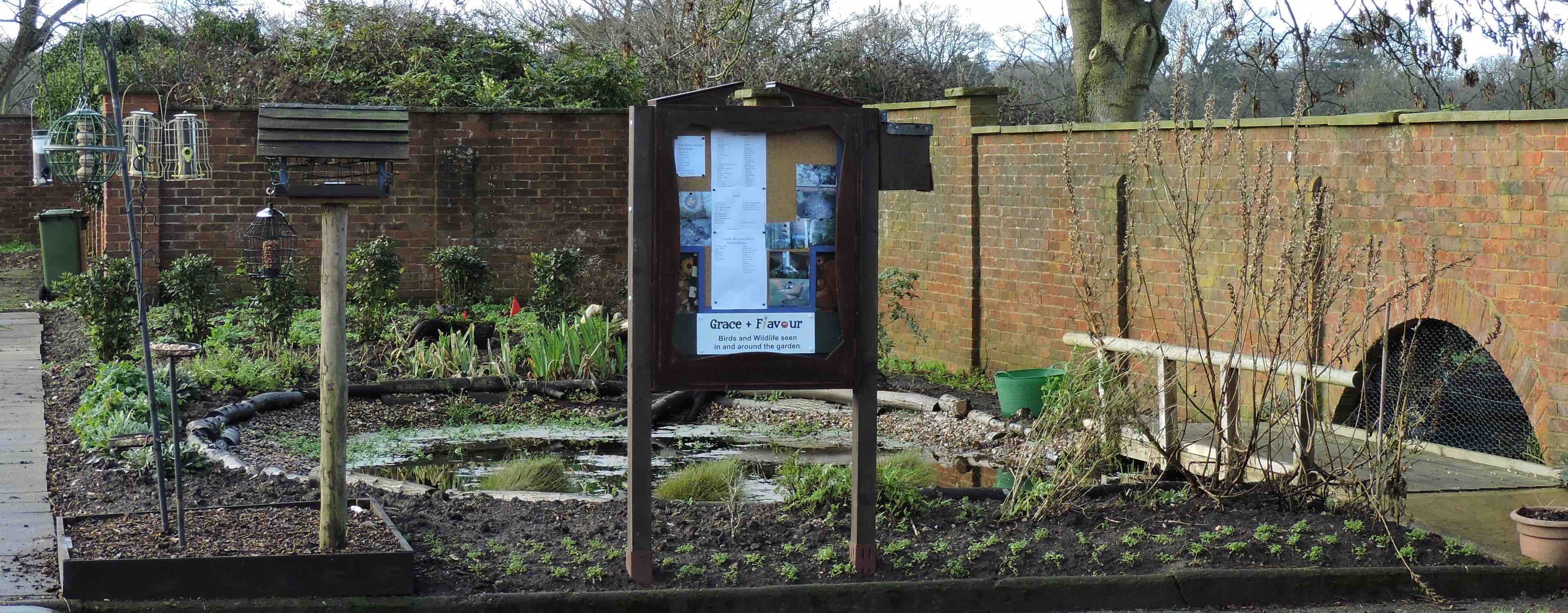
|
WILDLIFE IN AND AROUND THE GARDEN
Wildlife Update ................................................................February 2023
Wildlife Report February 2023 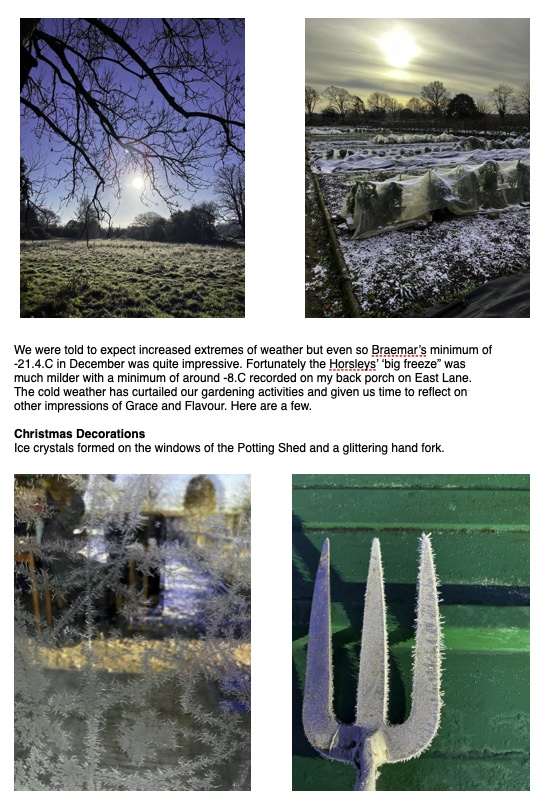
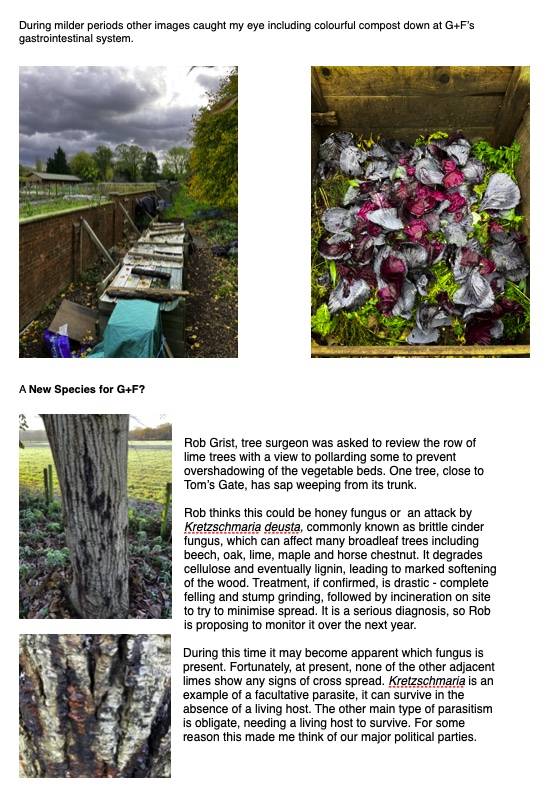
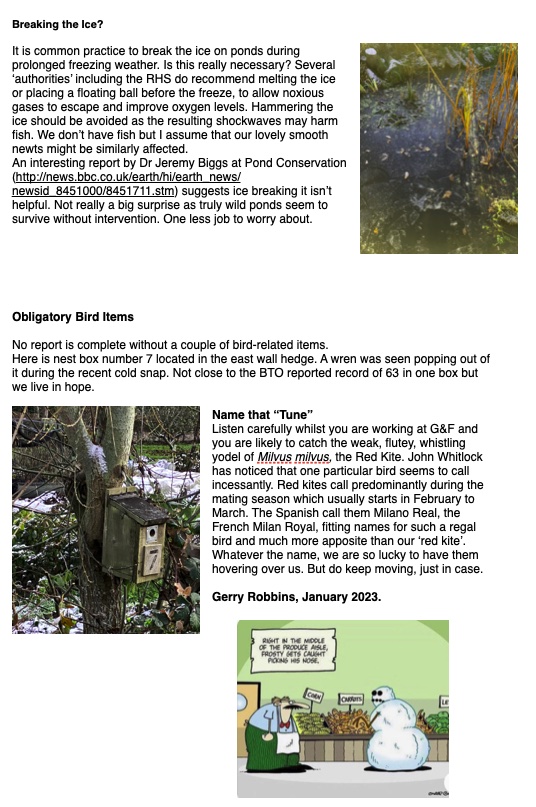
Enjoy! Gerry Robbins July 2022 Wildlife Update .....................................................................July 2022
Wildlife Report July 2022 Anyone interested in gardening or wildlife will be well aware of the recent lack of rain. National statistics show rainfall in the South East in June was only 60% of the long term average. Lawns are turning brown, soil is dry and dusty so it is all to easy to worry about the impact on wildlife, not to mention our vegetable cultivation. In reality most plants and wildlife adapt well and will “bounce back” following a good spell of rain. Hedging In spite of the above the northern boundary hedge is looking lush…..due to impressive weed growth! Most of these have been removed by hand. The newer, eastern boundary infill hedging has lost around 5% of the initial planting. These will be replaced over the coming winter season. The rest of the hedging looks very healthy following a couple of good soaks with a hose, it being its first year. The Pond 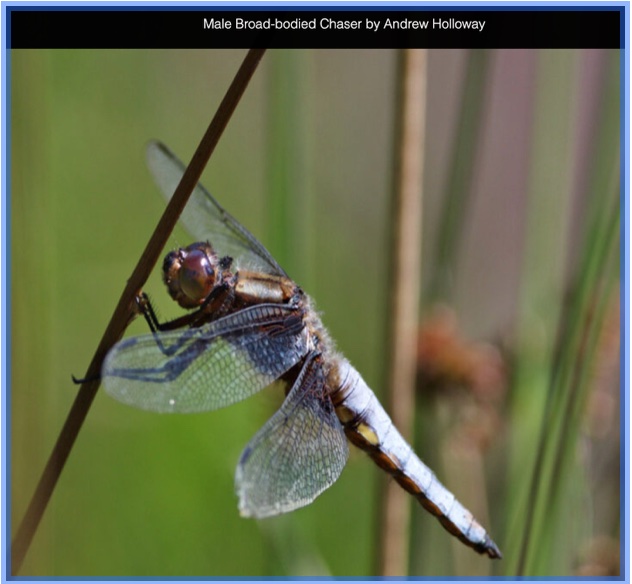
Not much new to report here. The water level has dropped significantly during the dry spring. This has been addressed by repeated, small top-ups with mains water. This approach allows chlorine to gas off and maintain normal pond water chemistry. Blue and red dragonflies and broad bodied chasers have been in evidence. The chasers are quite large, stubby dragonflies that, as their name implies, can be easily spotted coursing around the pond perimeter looking for trouble! Nest Boxes Following the previously reported survey in mid April, the boxes were resurveyed on 19th May and 26th June. As in recent years only blue tits, great tits and stock doves have nested successfully. We have plenty of other birds on site, including robins and wrens, but they seem to prefer natural nesting! Here are the headlines from the census. Twenty two boxes are currently in place. Of these,11 were occupied by nesting birds. This is a similar proportion to last year. 
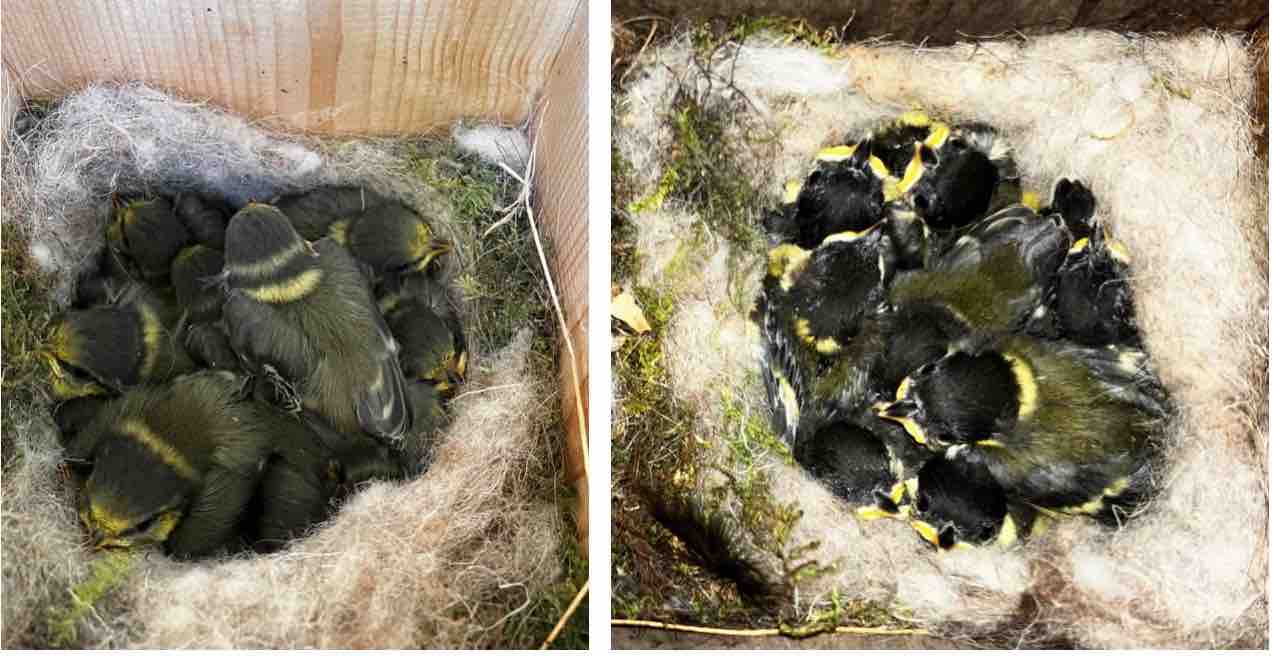
At least 22 blue tits (possibly 30) and 16 great tits fledged. Great tits are down on last year (when we had 26 fledglings). The two photos show the difference between blue tit and great tit chicks in the nest. I’ll leave you to work out which is which! 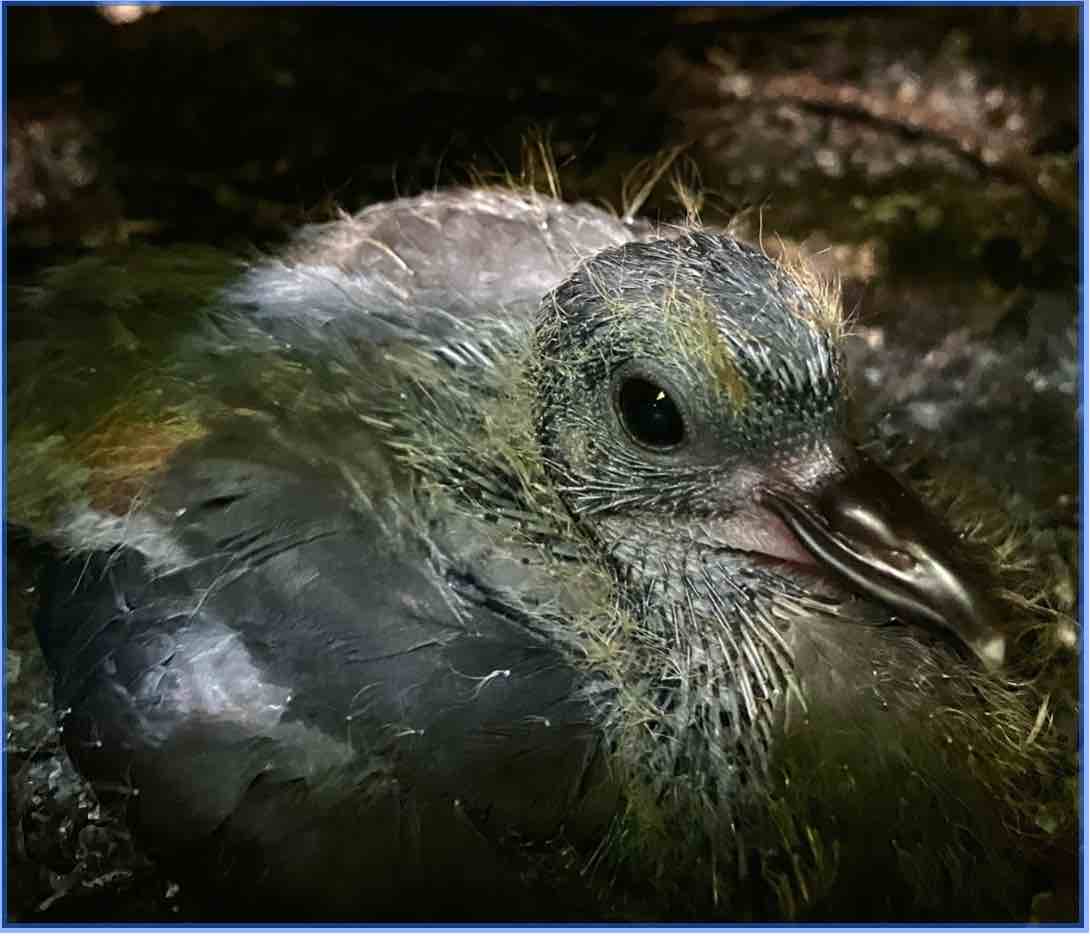 Here is a photo of one of our cute stock dove squabs. Stock doves usually lay two eggs which are incubated for 16-18 days. The young take around 20-30 days to fly. There may be second or third broods.
Here is a photo of one of our cute stock dove squabs. Stock doves usually lay two eggs which are incubated for 16-18 days. The young take around 20-30 days to fly. There may be second or third broods.
This year one box was used by wasps, producing a beautiful egg-shaped nest made of delicate parchment-like chewed wood fibre. (see photo). Apparently nest boxes are commonly used for wasps’ nests, something I need to consider carefully when checking our boxes! 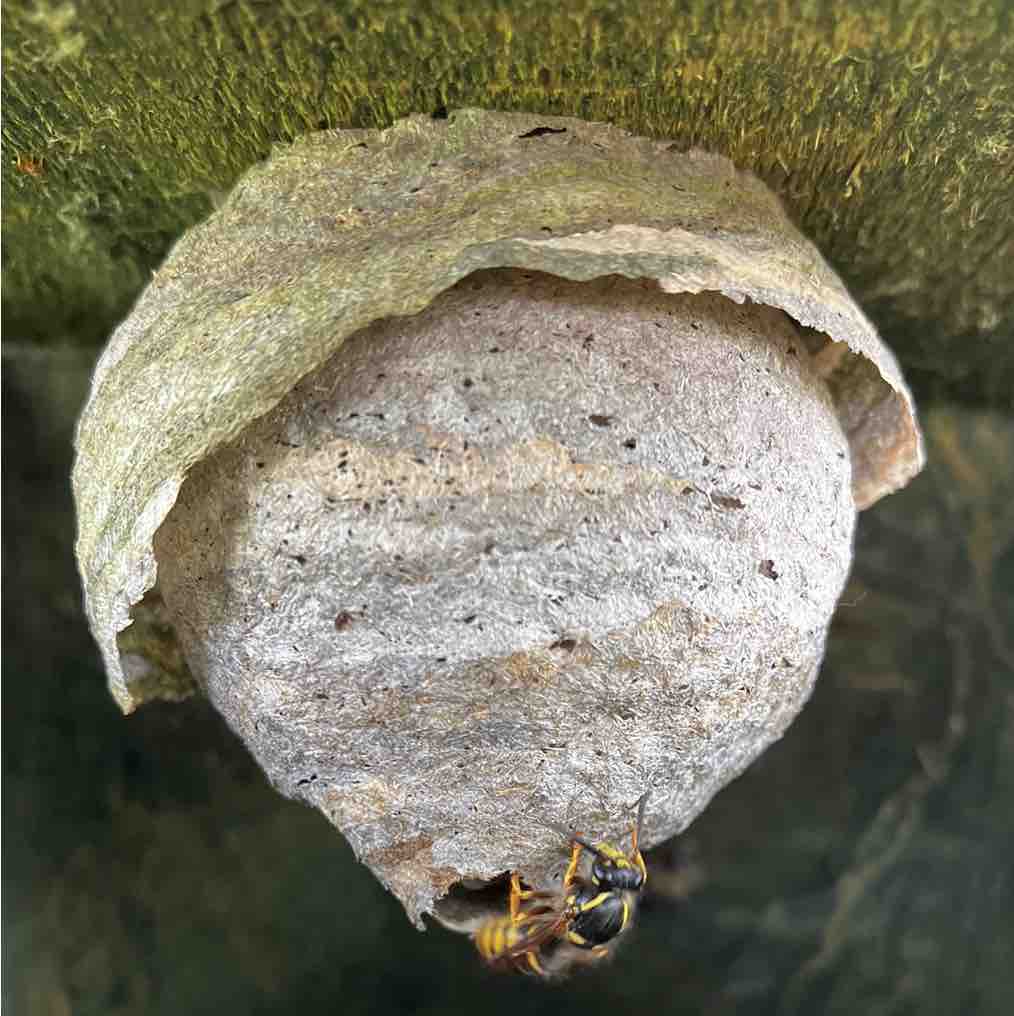
Kestrel Excitement 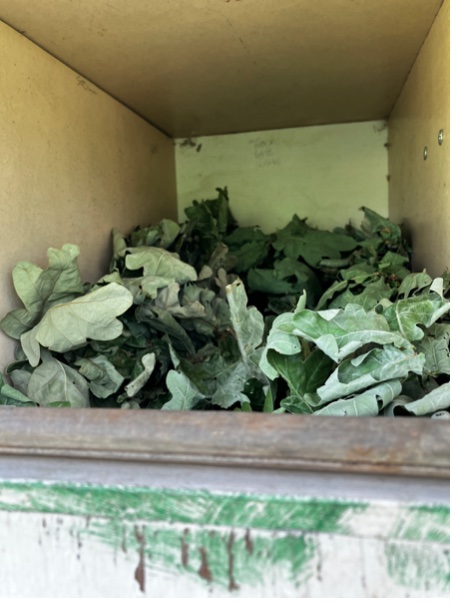 A pair of kestrels have been frequenting the garden this spring, raising the exciting prospect that they might use our nest box. On inspection it has been almost filled with oak leaves between mid May and June. But I think this is the work of a grey squirrel rather than a kestrel! The box may need to be placed higher in a tree to attract a kestrel or owl. Something to consider this winter. In the meantime we can enjoy the elegant aerial acrobatics of these very attractive falcons.
A pair of kestrels have been frequenting the garden this spring, raising the exciting prospect that they might use our nest box. On inspection it has been almost filled with oak leaves between mid May and June. But I think this is the work of a grey squirrel rather than a kestrel! The box may need to be placed higher in a tree to attract a kestrel or owl. Something to consider this winter. In the meantime we can enjoy the elegant aerial acrobatics of these very attractive falcons.
Other Sightings 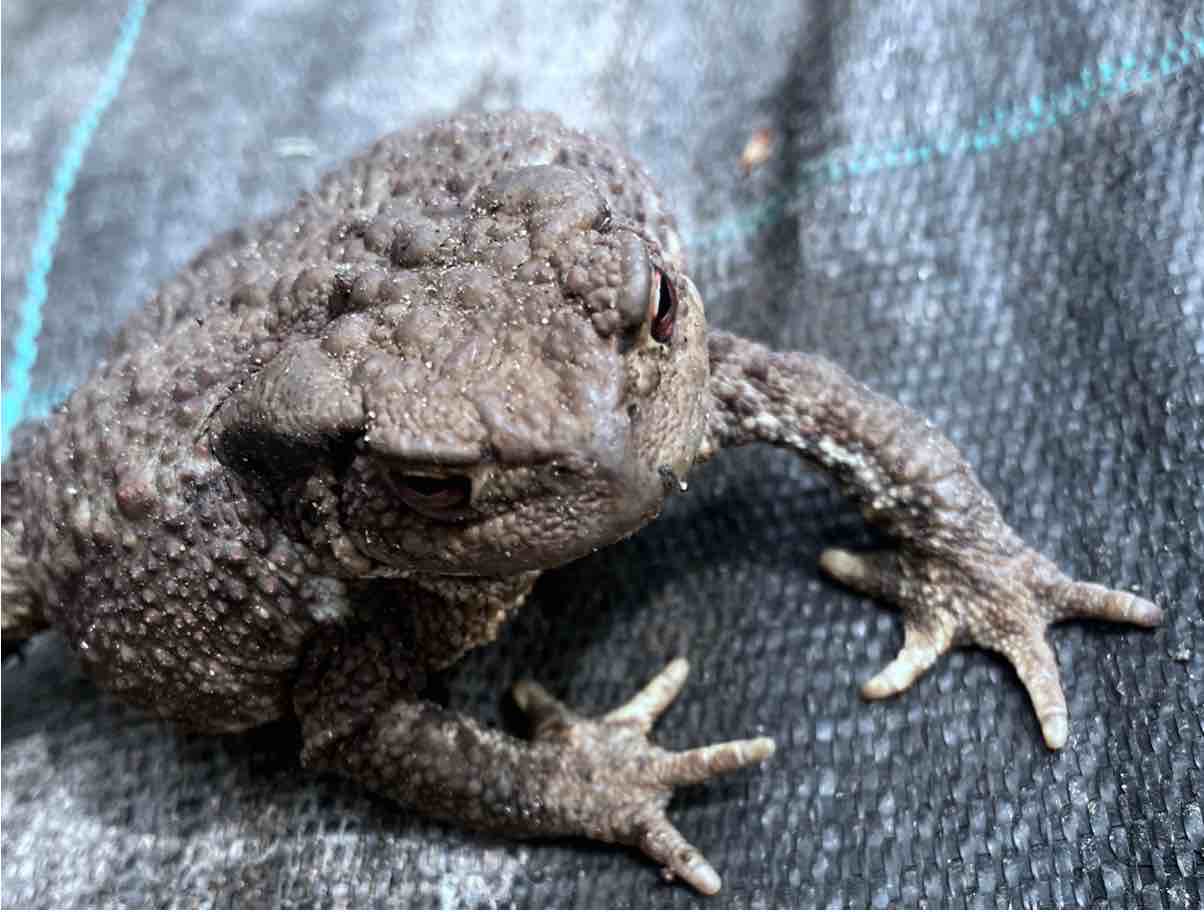
We seem to have more than our fair share of toads this year. These are usually discovered whilst working in the vegetable beds, moving sheets, stones and other items. They are obligingly sedentary and so easy to photograph in close up. We always replace them carefully as close as possible to where they are found. This mouse sadly ran across mypath just as I was chopping weeds with a sharp spade. A brief squeak was followed by death even though I could not see any external injury. RIP 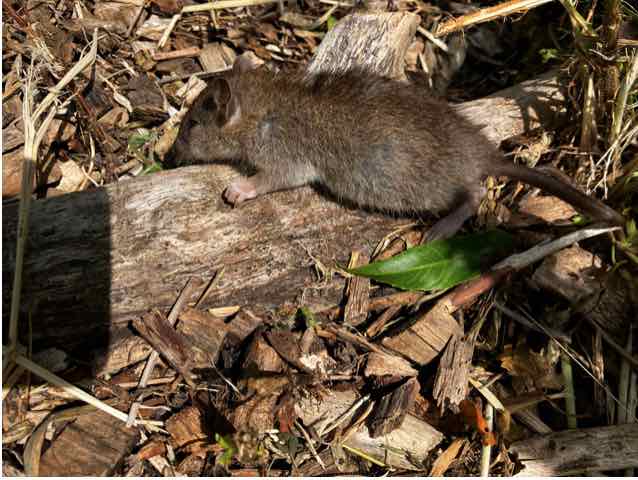
Insects of Note This impressive mosquito-like fly was found perched on one of our nest boxes. It measures around 15mm in length. Does anyone know what it is? 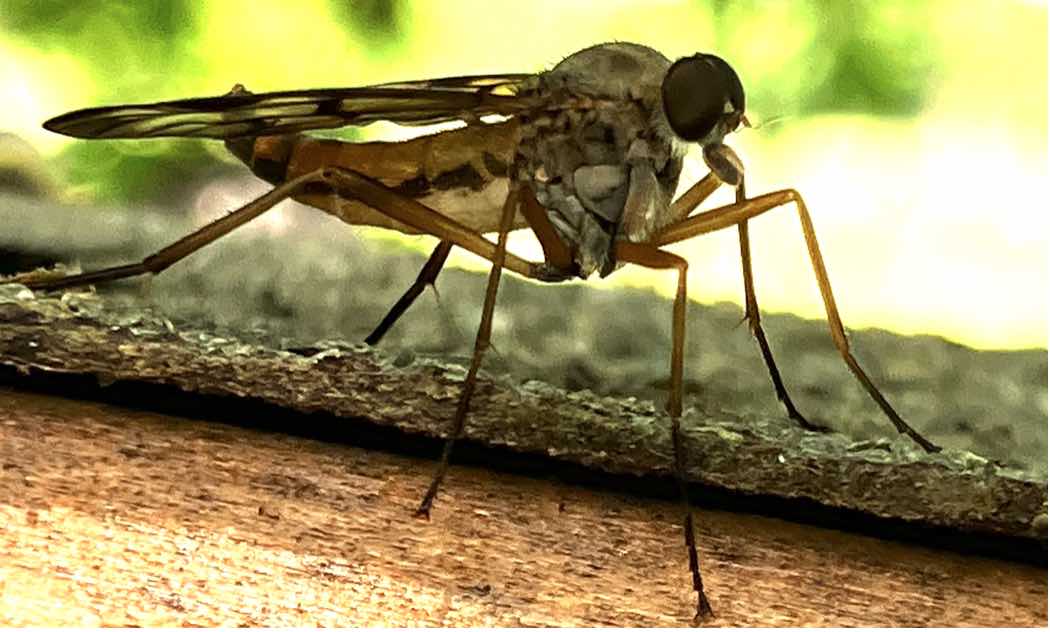
This next insect strikes fear into the heart of any gardener with box plants. 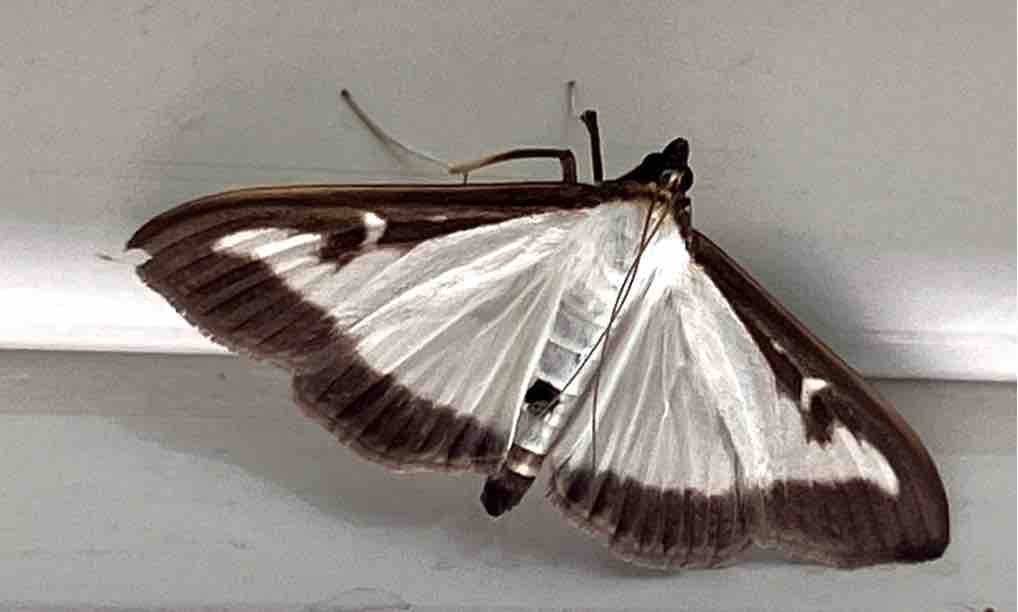
This Asian box moth has caterpillars that hide in box plants and slowly munch their way through the leaves leaving a denuded plant. This moth was found in our lounge! I am not aware that they eat vegetables or flowers so Grace & Flavour should be spared, but I thought it too good a photo not to show you. I will leave you with two other photos. First the newly planted lavender corner next to the pond notice board. It features Hidcote lavender, and a single Buddleja “Lochinch” raised from a cutting. Second, a small tortoiseshell butterfly on one of Helena’s beautiful astrantias. 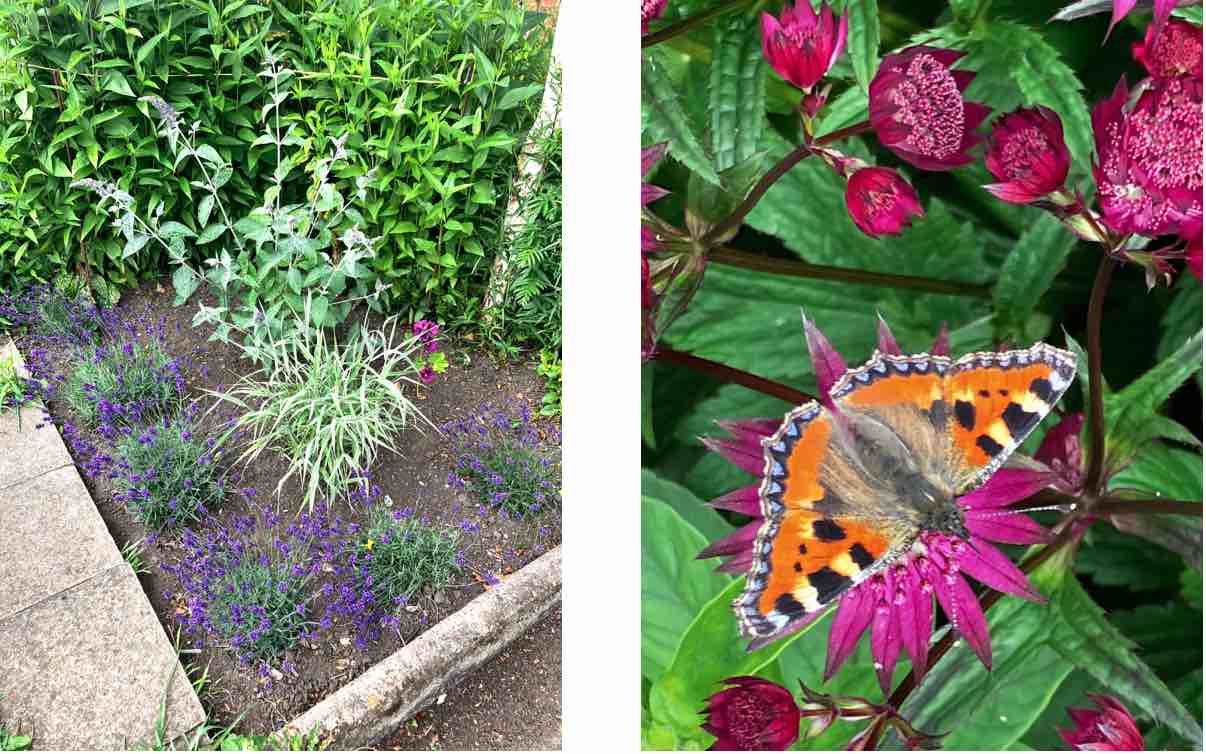
Enjoy! Gerry Robbins July 2022 Wildlife Report April 2022 A recent warm spell with clear blue skies has ushered in a fine spring and raised our spirits. It has been great to hear the cacophony better known as the dawn chorus even though it has stopped some from getting back to sleep in the early hours. From a wildlife perspective this has been a fairly uneventful season with one worrying exception. Read on to find out. 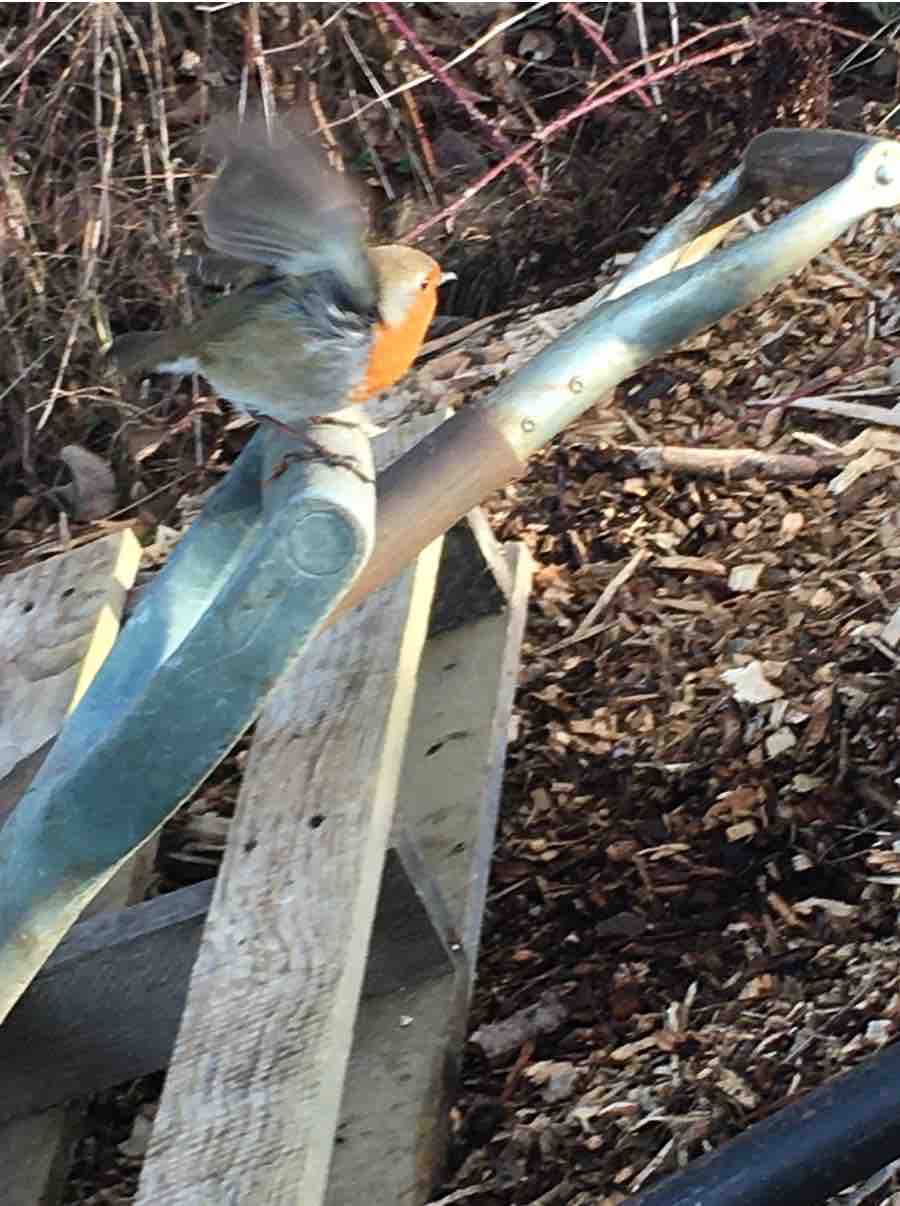 Hedging
Hedging
First a quick update on our two newish sections of hedging. The northern boundary hedge has come through its winter ordeal by horse bites with flying colours. It is showing good new season growth. We will shortly be removing the protective netting as it is required elsewhere in the garden. We will be monitoring very carefully in case our neighbours put livestock back in the adjacent paddock and they take a fancy to the hedge again. The east wall infill hedging did get rather battered sideways by Storm Eunice in February but no serious damage was incurred. This shows the advantages of planting whips as opposed to larger maiden trees and the importance of good quality stakes. The damage was quickly rectified by straightening and heeling in. Its great to see the new season’s growth already appearing on most of the plants. We may need to water the hedging given the current dry and warm conditions. The Pond 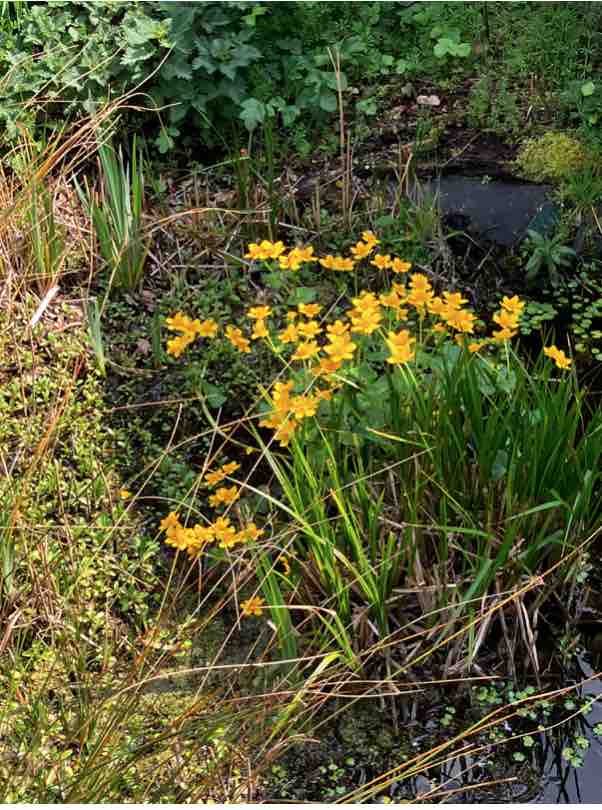 Many thanks to Ashley Brown for helping me clear a great deal of excessive plant material (mainly Iris pseudacora) from the the pond. It is now easier to see the smooth newts frolicking in the spring sun!
We have also removed most of last season’s excess / dead growth from the surrounding bed.
Many thanks to Ashley Brown for helping me clear a great deal of excessive plant material (mainly Iris pseudacora) from the the pond. It is now easier to see the smooth newts frolicking in the spring sun!
We have also removed most of last season’s excess / dead growth from the surrounding bed.
The corner by the notice board has been cleared and replanted with a single Buddleja Lochinch and edged with lavenders chosen and planted by Tom Suffolk. This should make a nice nectar corner, close to the pond, for bees and butterflies during high summer. Marsh marigold (Kingcup) is a very reliable early spring marginal native with bright yellow flowers that amplify any sunshine available. Nest Boxes The annual clean up, repair and replenishment of boxes was carried out in February. No unusual winter lodgers were found. The large dove box formerly on the ash tree by the pond was moved to a large lime at the north west corner of the plot just in case the NT decide to remove the ash tree because of ash dieback. Similarly two tit boxes, removed from the large old silver birch in the allotment area, were redeployed to the limes outside the west wall. This is because the birch may need to be removed for safety reasons and nesting would force the work to be delayed. An additional robin box has been placed in a very secluded spot to see if we can have more luck than in previous years. In total we now have 24 boxes in situ. 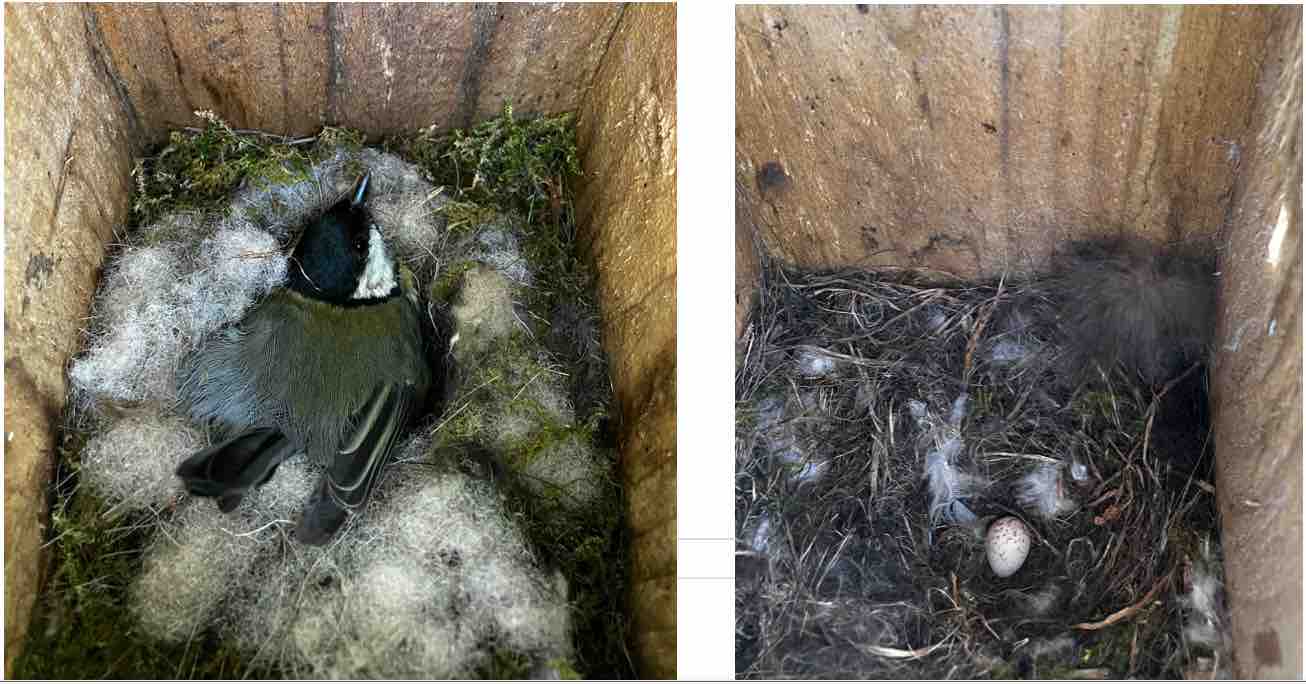
A nest box survey was carried out on 17th April which showed only one tit box with one solitary egg, one with a great tit sitting on the nest and one dove box with two fairly mature stock dove squabs. (I was unable to get a good photo of these). An additional 11 boxes showed evidence of nest building. These figures contrast sharply with the same time last year when we had 2 blue tit nest with eggs and 2 with a brooding adult, 2 great tit nests with eggs and 1 with a brooding adult. Let’s hope that the difference is just down to a “late” spring this year and we will see catchup over the next month. Several of the boxes in the general allotment area were found to have their catches undone, even though they had been left closed after their previous inspection by me. This is a worrying finding which we will be investigating further. In late March one of our sharp-eyed members spotted a large bird going into one of the large boxes in the lime tree. Was it an owl? With some excitement, I placed a wildlife camera close to the box. It recorded a lot of to-ing and fro-ing. A typical shot is shown below. 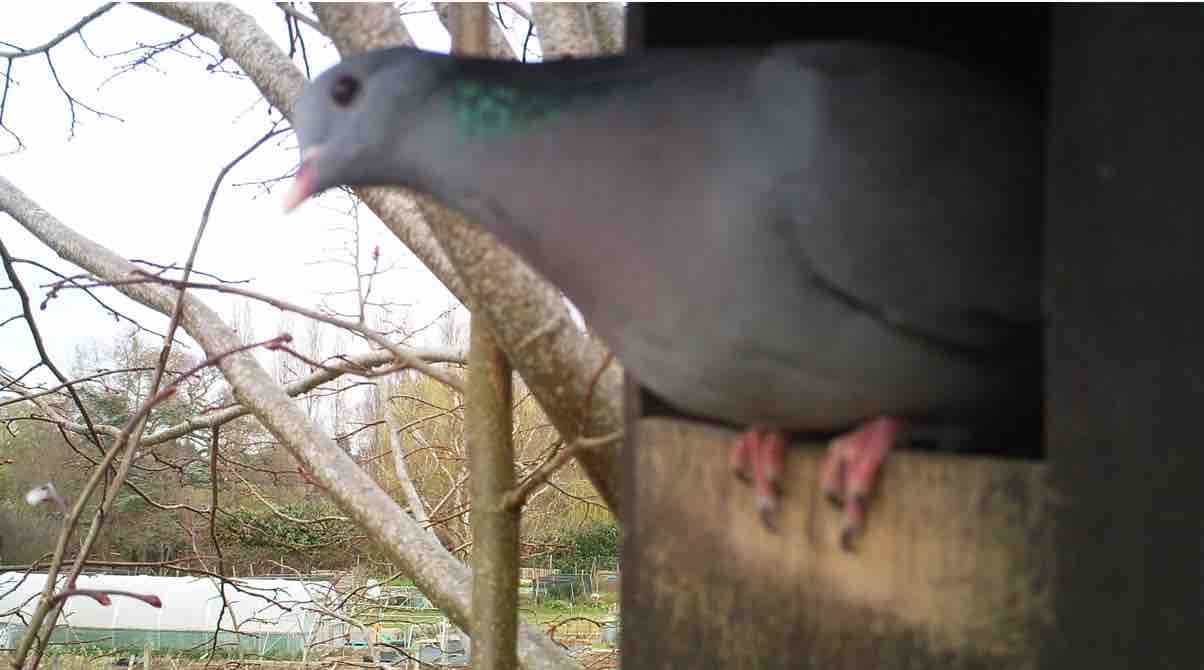
Not a bad image of one of our stock doves! It shows the lovely iridescent nape feathers and blush in the throat. At night it also caught a large slug happily inching along a branch some 15 ft off the ground. What they find up there is anyone’s guess! I mention this incident to remind me to encourage everyone to report any wildlife “spots” or events. You never know what you are going to find, but it is usually interesting. 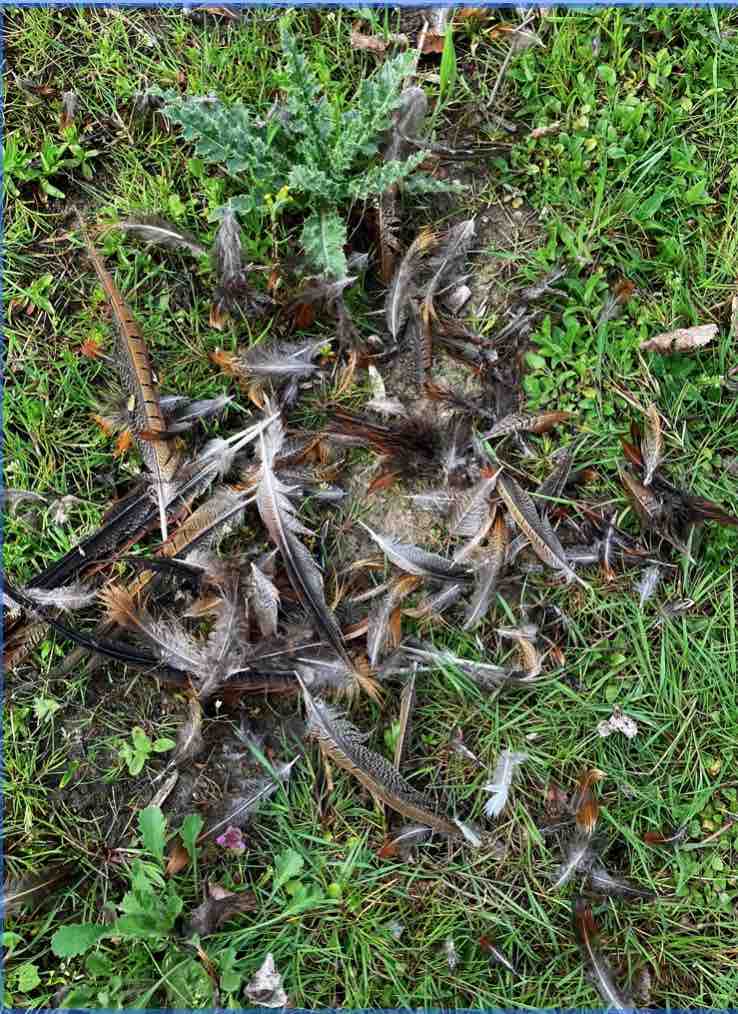 A Pheasant Meal?
A Pheasant Meal?While carrying out the above survey we came across this collection of beautiful pheasant feathers. No carcass was found. My guess is it may be the remains of a cat or a fox’s supper as it would be too large for local birds of prey to carry off to a perch or nest. Its Not a Trap! After further investigation and for a number of different practical concerns, we have decided against placing moth traps in the garden. Time to Move Now the risk of heavy frosts is past it is time to move our painted frog mascot from his winter quarter in the potting shed, back out to his summer residence by the pond. He should enjoy the change of scenery in spite of the vastly improved appearance of the potting shed following the massive clean up a month ago! Dawn Chorus and Bioblitz Event 14th May At least once a year in spring or early summer I rather masochistically arise at around 430am and head off to Grace and Flavour or some patch of local woodland to be aurally saturated by the dawn chorus. It should be on everyone’s bucket list. This year Surrey Wildlife Trust and West Horsley Place are hosting a special dawn chorus at 5am on Saturday 14th May, followed from 10am onwards by a 24hr Bioblitz event at which Grace and Flavour will have a presence. Booking is required. Please see https://mailchi.mp/149230b22e20/lunch-dec-5828733 for further details. More photo's have been added to the wildlife gallery (click the Wildlife button) if you would like to take a look here. Click Here to read more about wildlife in the garden. Click Here to read previous wildlife updates from the garden. Keep looking up. Gerry Robbins April 2022 Wildlife Update .....................................................................January 2022
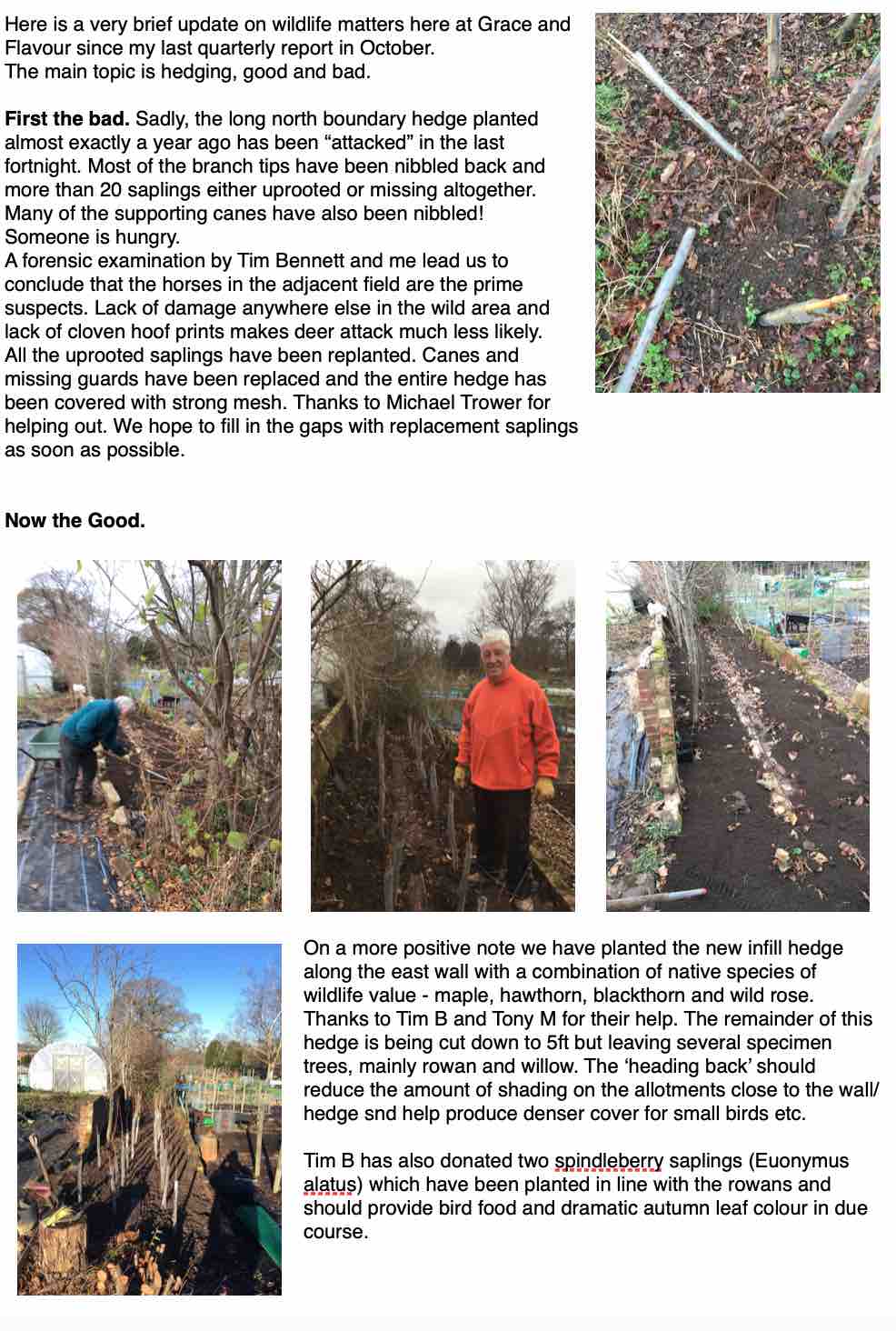
Wildlife Spots The main spectacle has been the recent breathtaking aerial displays by red kites, up to four at a time, close to the north wall. We have been afforded some excellent views of their aerobatic skill and wonderful plumage colours particularly apparent when the afternoon sun is low in the sky and illuminates the underside. It makes a welcome change from the usual dark silhouettes. John F has been trying to photograph them but without luck so far. Watch this space. Its a Trap! Later this year we would like to set up a moth trap to survey what types of moths are present locally. If anyone has a trap (for moth appreciation not killing!) or knows anyone who has one, please let me know. Birdsong It may be wishful thinking on my part but, even through the current relatively cold snap, there seem to have been more birdsong than expected at this time of year. Could they be thinking of establishing territories for breeding already?! I better get on and clean out all those nest boxes. More photo's have been added to the wildlife gallery (click the Wildlife button) if you would like to take a look here. Click Here to read more about wildlife in the garden. Click Here to read previous wildlife updates from the garden. Enjoy the wildlife the rest of the summer has to offer, no matter how wet. Gerry Robbins January 2022 Wildlife Update .....................................................................October 2021
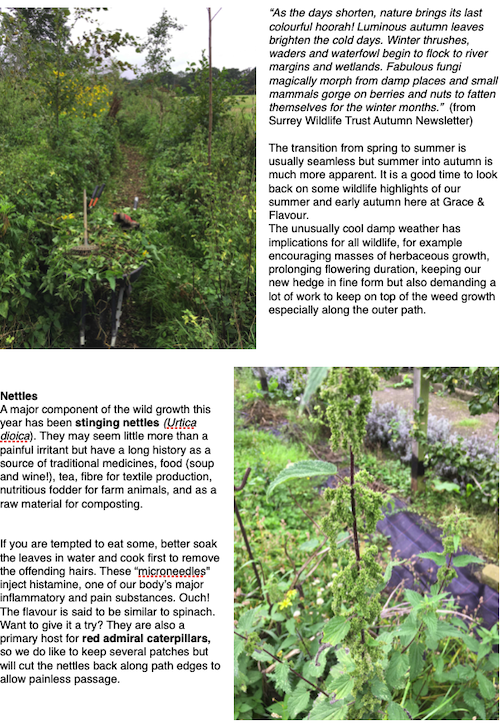
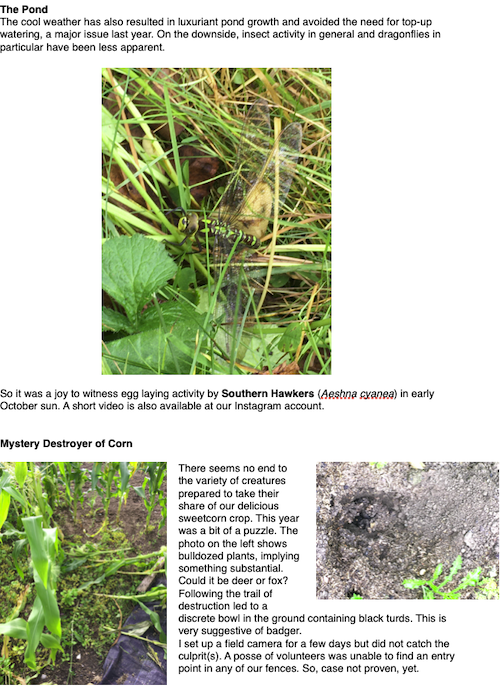
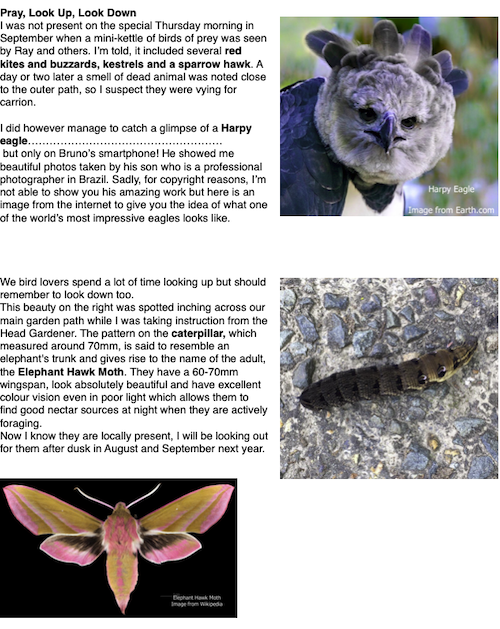
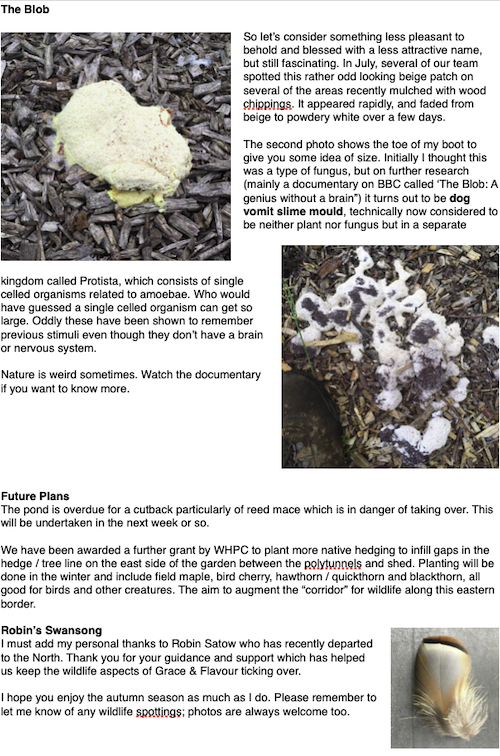
More photo's have been added to the wildlife gallery (click the Wildlife button) if you would like to take a look here. Click Here to read more about wildlife in the garden. Click Here to read previous wildlife updates from the garden. Enjoy the wildlife the rest of the summer has to offer, no matter how wet. Gerry Robbins October 2021 Wildlife Update .......................................................................July 2021
Looking back at my last seasonal report (April 2021) I see I was concerned about the risk the dry weather posed to our newly planted hedge. That dry spell has been followed by a very variable weather pattern with frequent refreshing rain, amounting to twice the seasonal average. Unfortunately however, this, together with low temperatures, has made it a difficult nesting season for small birds. On a more positive note, the air has been full of bird song: blackcap, whitethroat, song thrush, greenfinch, goldfinch, wren, swallow, swift, green and greater spotted woodpeckers to name a few.  Nest boxes: Checking the nest boxes on site involves lugging heavy, extending ladders around whilst avoiding trip hazards, climbing to some height, manipulating a phone camera and carefully lifting the lids to take a quick snap with minimum disturbance to the occupants. It is worth the effort though just to get a glimpse into this otherwise rather cryptic world.
Nest boxes: Checking the nest boxes on site involves lugging heavy, extending ladders around whilst avoiding trip hazards, climbing to some height, manipulating a phone camera and carefully lifting the lids to take a quick snap with minimum disturbance to the occupants. It is worth the effort though just to get a glimpse into this otherwise rather cryptic world.
The number of boxes occupied this year is very similar to last year as are the species of occupants, but the clutch sizes are greatly reduced. Roughly half the number of blue tit chicks and sadly one eighth the number of great tits. This seems to have been mainly due to reduced clutch sizes rather than nest failures (dead or predated chicks). If you want more details, see the table below. Photo: Blue Tit Chicks TABLE showing nest box activity at Grace & Flavour, 2020 and 2021 compared 
The New Hedge: This is growing away in a very healthy fashion due to regular application of natural rainfall! So are the weeds! We plan to mulch the base of the hedge after a good hoeing. Let’s hope the saplings are big enough to take care of themselves by next spring. 
The Pond and Wildlife Areas: 
Thanks to Rob and his building team, the pond was given a good clear out early this spring and is looking picturesque at present although you will need to peep through the luxurious surrounding herbaceous plants which have also responded to the regular rain. Large red damselflies have been up to their usual mating activities, but very few dragonflies so far. The pond continues to support a good population of smooth newts but the number of pond snails seems to have reduced according to my conchological partner. A large plan of the wildlife area has been put on the noticeboard to assist visitors wanting to understand the layout. 
Recent Wildlife Sighting and Incidents Let’s start with some random photos of flowers and foliage taken in the wildlife area in the last week or so. 
Feathered Encounters 

Please keep your eyes peeled for birds trapped in the fruit cage and other meshed beds. Once caught, hold them firmly to stop them injuring themselves, and release them in an open area with a clear flight path. Sexist Names? 
More photo's have been added to the wildlife gallery (click the Wildlife button) if you would like to take a look here. Enjoy the wildlife the rest of the summer has to offer, no matter how wet. Gerry Robbins July 2021 Wildlife Update .......................................................................April 2021
Spring is here bringing an exciting burst of growth and wildlife activity. The recent high pressure system is yielding overnight frosts, clear blue skies but not much rain. The latter aspect is a concern for our recently planted wildlife hedge. Regular watering is frowned upon as it may encourage the growth of superficial roots but a quick test showed very dry soil in the hedgerow so needs must. The hoses are in demand during the day in the vegetable garden at present so a very early start seemed a good opportunity to use the soaking hose, to record the dawn chorus and observe the local bird life without disturbance. What a pleasure to be greeted by such a symphony of birdsong. On opening the car door. I heard the following species: wren, great tit, blackbird, robin, wood pigeon, pheasant and later blackcap. You can hear a clip of the initial chorus at the G&F website. During the three hours I was on site I also saw and / or heard carrion crows, red-legged partridges, kestrel, blue tits, goldfinches, greater spotted woodpeckers, tawny owl and chiffchaffs as well as a heron and a gull flying over. I spotted a robin with nesting material (see photo). 
It was lurking by the north polytunnel but I was unable to find the nest. Perhaps it was as confused as me. Not sure I should also report that I saw a pair of pheasants getting very friendly out by the manure heap at the South West corner! (see photos). 
Checking 18 of the nest boxes revealed 12 with fresh nesting material (although see below) and three with eggs (see photo for “eggsample"), all of them either great tit or blue tit, I think. The nesting season may have been delayed a little by the rather cold nights so I am sure will will see much more activity when the boxes are checked agin in four weeks time. 

The kestrel box placed last autumn contains a beautiful bed of cedar tree twigs (see photo) with a neat bowl at the closed end. I suspect this may be a squirrel’s dray but further investigation is in progress. A few words on nest box design. Different species prefer different sized and shaped boxes (see photos). A few general points. The boxes should be sited out of direct sunlight and with a clear flight path if for larger birds. Untreated timber with a waterproof roof is preferred. The lid should be hinged for easy viewing. The box should be easily detached from its fixing (small boxes) or have a trapdoor to allow thorough cleaning during late autumn / winter. The RSPB and BTO have excellent information on bird box construction, siting and care. I have added a few pictures showing the various designs in use at G & F. 
Early spring is an optimum time for bird watching for many reasons. Birds are particularly active at this time, busy with courtship, making nests, feeding up ready for egg laying and later to bring food to the nest. Trees and shrubs are not yet fully in leaf making watching much less frustrating. Even the wood pigeons look good! Spring is not all about birds! Recent butterfly sitings include brimstones (often the first to appear), orange tips and a single tatty comma. Bumblebees abound but there are not many honey bees around since we removed the hive last year. It is also a time for pond clearance. Debris should be left at the side of the pond for a few days to allow creatures such as smooth newts to return to their watery home. Enjoy the rest of this beautiful season. 
Wildlife Update .......................................................................February 2021
 It has been a cold, wet winter with significant snowfalls and temperatures as low as -8°C. In spite of this the red legged partridges have continued to entertain us around the garden. Cold easterly winds brought in the usual flocks of fieldfares and redwings which settled in the lime trees looking for holly berries to gorge on. I was surprised to see our orange Buddleja bush in flower in late December but no sign of butterflies! It has always been a mystery to me how small birds survive during these cold winters. The truth is, many do not, but survival is helped by a whole range of adaptations, anatomical, physiological and behavioural. You can help by putting out high energy food and providing fresh water.
It has been a cold, wet winter with significant snowfalls and temperatures as low as -8°C. In spite of this the red legged partridges have continued to entertain us around the garden. Cold easterly winds brought in the usual flocks of fieldfares and redwings which settled in the lime trees looking for holly berries to gorge on. I was surprised to see our orange Buddleja bush in flower in late December but no sign of butterflies! It has always been a mystery to me how small birds survive during these cold winters. The truth is, many do not, but survival is helped by a whole range of adaptations, anatomical, physiological and behavioural. You can help by putting out high energy food and providing fresh water.
All the nest boxes have been cleaned out and repaired ready for the spring nesting season. A couple of additions have been made, one large box for stock doves as all of last year’s boxes were occupied and a new robin box courtesy of Bob Spackman. A large tree stump complete with rotting base was excavated at the back of polytunnels. We plan to sink this 30cm into the ground in the wildlife zone to make another beetle habitation. West Horsley Parish Council have generously supplied a mix of native hedging including hawthorn, privet, crab apple, hazel, wild pear, plum cherry, buckthorn, dog rose, holly and field maple. These will be planted along a 40 metre section of the barbed wire fence forming the northern boundary of G & F when the weather allows. Before and after pictures to follow. It should provide an excellent habitat for insects and small birds. I am sure, like me, you are looking forward to spring. Let’s hope it is as glorious as last year. I’ll be reporting again in May to update you on all the nesting activity. Gerry More photo's have been added to the wildlife gallery (click the Wildlife button) if you would like to take a look here. Click Here to read more about wildlife in the garden. Click Here to read previous wildlife updates from the garden. New Hedging Corridor at Grace and Flavour
The northern edge of the walled garden is our wildlife zone. The pond passes under the frost arch leading to the main wild area, a strip running outside the length of the northern wall. This is planted with bee and butterfly friendly wildflower perennials, nettle patches and buddlejas. It also includes several log piles for invertebrates. Two years ago all of the rough scrub of brambles and shrubs, adjacent to the wall was cleared to facilitate repairs to the wall. Although rather scruffy, this sort of dense scrub is an important habitat for all sorts of wildlife. It was also noted that the northern boundary of our site consists of a rather stark barbed wire fence of very little wildlife value. Co-incidentally an offer was received from West Horsley Parish Council via Councillor Sally Newman to fund hedge and tree planting at Grace and Flavour. We decided that a mixed hedge of native tress and shrubs along the 40 metre length of this fence would provide a more pleasing border with plenty of opportunities for perching and nesting birds, a good source of food for them, for insects and other wildlife. It would also creates a corridor for creatures to move to and from adjacent areas of the garden. This proposal met with the approval of our neighbouring land owners, West Horsley Parish Council and the National Trust as owners of the G&F Site. We are very grateful to WHPC for their financial support which has allowed this project to be realised. Here is how the border looked in early February 2021 after Robin Satow’s excellent preparation. 

The bare rooted saplings were heeled into a spare vegetable bed until the weather was suitable for planting later in the same month. Here is the hedge after planting. It may look rather insubstantial now but from tiny saplings a useful hedge can grow. 

The species mix includes hawthorn, privet, crab apple, hazel, wild pear, plum cherry, buckthorn, dog rose and field maple. At the east end, adjacent to the large oak tree, we have planted several more shade tolerant holly trees. Their berries are a delicacy for thrushes including winter visiting fieldfares and redwings. At the north west corner we have planted a small coppice of hazels. We look forward to seeing our efforts grow into a healthy hedge and to enjoying the wildlife it accommodates. My thanks are due to Robin who did the lion’s share of the digging and planting. 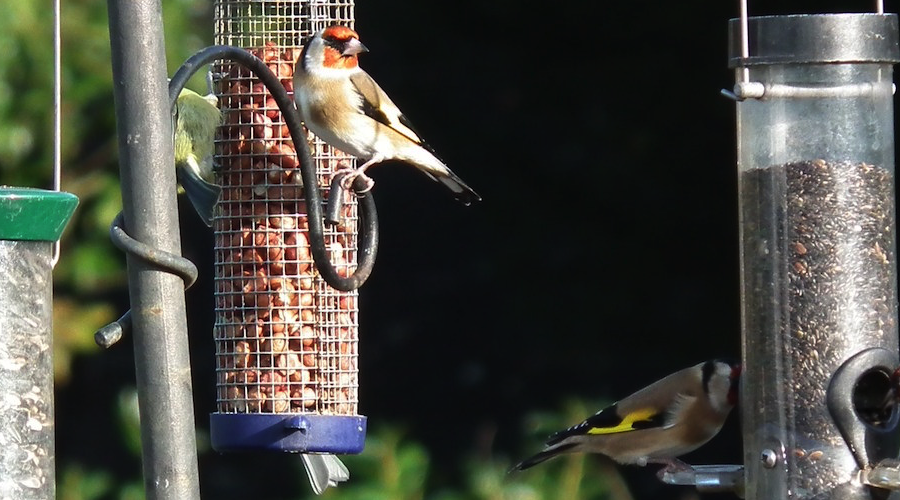
Gerry Robbins Wildlife Update ..............................................................August 2020
Since my last update in April, a heatwave of a spring has given way to a summer with long spells of no rain and temperatures up into the mid 30s. In spite of this, the wildlife seems to have flourished. Wildlife Consultations Robin Satow has been an excellent link to knowledgeable local natural historians who have given freely of their time. These include Ben Siggery from Surrey Wildlife Trust, Roger Beck, Brian Austin and David Ross, the last three being particularly focussed on bird life. They have provided very helpful advice on the layout and management of the site for wildlife purposes, and reassuring us that we are generally on the right track. Nest Boxes The burst of nesting activity that spring heralds is truly remarkable. Take for example a female blue tit weighing around 11g and measuring 12cm. It manages to produce 8-12, even up to 16 eggs over a few days, incubates them and then with her partner and feeds the chicks more or less non-stop from dawn to dusk each day. They make several thousand visits to the nest. A miracle! So how successful were our boxes? Fourteen of our 20 boxes have been used this year so far. A total of 34 great tits (photo) and 33 blues tits (photo) have fledged from 4 boxes each. In addition so far 4 stock doves (photo) have fledged from two separate boxes and a further one is currently in use. Stock doves are especially welcome as they are Amber listed under the Birds of Conservation Concern Red lists (2015). Their breeding strategy is quite different to small birds like tits which have a single large clutch. Stock doves, like wood pigeons, lay 1-2 eggs in each clutch but have an extended season with 2-3 clutches per year. So far we have had four clutches in two separate boxes. As of this writing a third box has a sitting parent so we may yet break previous years records. Sadly, as far as I can tell, there have been no owls or ducks successfully nesting on site this year. Other Nature Notes G&F provides a great opportunity for chance wildlife observations. Net-skimming the pond to remove excessive floating weed usually reveals a soup of invertebrates and vertebrates. The skimmings are placed close to the pond edge so creatures have a chance to crawl back to the safety of the water. Honey bees took over one of the owl boxes and split into two swarms, successfully captured by two of our bee-keeping members. We have seen red kites, kestrels, buzzards and sparrow hawks, a family of red-legged partridges, grey wagtails, a barn owl hunting a dusk in the field opposite G&F. Insects include the lavender avenue a-buzz with honey bees, butterflies in variety and abundance, mint moths in the herb garden, cinnabar burnet moths, large red damselflies and broad loaded chasers patrolling the pond. And the year is not yet over. Several other photos and short videos can be seen on our gallery here, Facebook (https://www.facebook.com/groups/GandF) and Instagram (@grcommunitygarden) sites. Please take a look. Future Plans A ‘deluxe’ kestrel / owl nesting box is being constructed for one of our large trees. This will need an open flight path to allow easy access by the parents and fledgelings. If we can encourage more raptors to nest locally, this should help with the ecology of the garden. Several of the nest boxes will be re-sited when we carry out the annual cleaning in autumn. This will make them easier to check at nesting time. We have started to keep a list of bird species seen at, or close to, G&F. If this proves successful and time allows, we will add a miscellaneous list for all other interesting species. Every season brings a change. I am looking forward to cooler, damper days of autumn and the change in wildlife that this will bring. Keep looking and listening. Gerry Wildlife Update ..............................................................April 2020
Eddie our wildlife guru, left us last year leaving a big gap. He did a huge amount to encourage wildlife into Grace and Flavour and a huge amount to encourage us to take an interest in natural history. Thank you, Eddie. In the absence of a suitable replacement, it has fallen to a few keen amateurs like me to do their best to keep this important aspect of the Garden in flow. I’ll give a quick report on what we did in late winter and early spring before moving on to sightings. Roger Beck, a local bird expert, was invited to tour the garden with specific attention to the nest boxes. He was impressed by Eddie’s “legacy” and agreed to our proposals for additions and renovations. This lead on naturally to cleaning out all the boxes and repairing those in need. A major task was hoisting a three foot long mega-box into one of the large oak trees! Thanks to Trevor for his help with this. The position and number of the boxes has been noted on a copy to the site plan for future reference. Our thanks also to Robin and his woodworking colleagues who using materials supplied by Bob Spackman, fashioned numerous, classy, small bird boxes with armoured entrance hole surrounds to fend off voracious woodpeckers. Six of these have been placed in the allotment and main garden area and we eagerly await results. The next job was an early spring tidy-up in and around the wildlife pond, mainly gentle pond dipping to remove excess floating weed and cutting back dead flower stalks. The removed pond material was left at the side to allow vertebrates and invertebrates to crawl back in. Robin has a keen interest in wildlife issues and has been in contact with Surrey Wildlife Trust for advice about managing the site from a natural history perspective. We await their reply. I have added a Bee B&B to the south facing wall next to the pond. We will keep an eye on it to see if the Bee's use it for a rest soon. Sightings & Hearings Spring is here! A particularly significant one this year. We are in double need of the psychological benefits of contact with nature. The air and road traffic have reduced drastically and the sun is shining. All good for nature watching and listening. Here are just a few recent titbits. Redwings and Fieldfares spotted in the limes trees. Grey partridges making a hasty retreat. A pair of Mallards have now nested in the flower bed next to the pond so be aware if you are near that area. Skylarks singing in the field adjacent to G & F. Brimstone, Orange Tip and Comma butterflies flitting around. Honey bees flying in and out of their bird box hive on warm days. A Magpie robbing a Blackbird’s nest in the laurel hedge by the road. And a glorious cacophony of bird calls - the usual culprits but it is always cheering to hear the first Blackcap, Chiffchaff and Cuckoo’s call of the year here. Bats. A few seen so far. (I am hoping to use my home made bat detector to help identify what we have.) Thank you to all of you who have contributed to these sightings! Keep them coming! Bird Box Census We did a check of each box at the end of March. Several had nest material. Two had brooding Stock doves, each with two eggs. This is consistent with Eddie’s previous observations. The census will be repeated towards the end of April and May. I will report back. In the meantime, anyone who likes pulling Tansy out of the flower bed is very welcome to join me (at a distance of at least 2 metres). Tansy leaves were traditionally eaten at Easter to help kill off the worms that the diet of fish at the time caused. They are quite bitter, so were mixed with eggs, milk and flour in a kind of pancake or omelette. Help yourself and let me know how you get on. Enjoy! Gerry Wildlife Update from Ed..........................................................August 2019
Good day to you all. Spring has gone and the Summer is here already. So how has the Garden wildlife been doing, some good, some not as good as I would have liked. Bird Boxes Blue Tits have done well with 9 pairs successful we have on average 7 chicks per nest. Great Tits this year were up by over 100% on last year. Most years we have had 2 pairs nesting, one has always been in the same box by the gate but this year we have had 5 pairs, 2 of which took to nesting in the new Robin boxes with an average of 5 chicks. Robins, for the last few years have all fallen foul to the Woodpecker or Magpie predators, that is even when I added mesh to the front entrance hole of their boxes. I was going to stop putting Robin boxes out for this year but came up with a cunning plan....See Photos to the right. 3 boxes were used. Robins can breed up to 3 broods in a year. I know one box was used twice. This year I wanted to leave them in peace and let them get on with it so the average hatching is unknown. Stock Doves are on the decline so I'm happy to say we had 2 pairs nesting through this year with two chicks each time, at the last count we had had 6 hatchings and there will still hopefully be more. Mandarin Ducks have bred in the garden for 7 years now, one pair for 6 years plus last year we had 3 pair. Unfortunately this year they wehave been missing, I was so looking forward to seeing them again. We have to wait until next year to see if they will return. No Owls yet again this year. The pond looks better every year, alive with insects, newts and dragon flies, also with the usual plants and trees. Again no frogs and tadpoles. Where are they? Around the back, behind the pond wall, we have had a good clean up, the brambles removed, over 20 trees planted plus lots of shrubs. Wild flowers are now blooming. The whole area looks fantastic now. Bumble Bees, Honey Bees and Butterflies are every where accross the garden now, helped greatly by Tom's Lavender Path which attracts plenty of insects. Lastly, Honey Bees have taken over an Owl Box, for me that's the icing on the cake. Well that's it, enjoy the rest of the Summer. Have a good one Ed Wildlife Update from Ed..........................September 2018
Hi, this year has been I would say the best so far. Mandarin Ducks, not one pair nesting but three wow, need to put up some more duck boxes. Their usual box had 11 eggs, the other 2 caught me out, but alas the one who nested in the Kestrel box was predated by squirrels. (I Think) In another box 12 tits were alive, 9 blue tits and 3 great tits, out of that 2 blue and 1 great tit didn't make it, so sad to find a nest full of dead chicks, but I see that every year. It was still a good year for G&F, Robins, 3 boxes and all predated yet again, G/S Woodpecker or Magpie. I have designed a new box and will try it out next year, roll on Spring. Our lovely Mallards tried twice to nest in the garden this year, but even though they had the chance to hatch the eggs, the fox got to them. We also had 2 pair of Stock Doves nesting in our boxes , two broods each totalling 7 young. Blue Tits, 57 young fledged, Great Tits 10 young fledged, aproximately. The wildlife pond has been getting wilder. At the moment I'm taking down all the boxes a few at the time to clean out and repair at home to return looking new, remember to clean your box out for next year. Have a good one Ed Wildlife Update from Ed....March 2018
Happy New Year, a bit late I know. All nest boxes have been cleaned out apart from five which had mice nesting in them, I will evicted them at the end of February. I left them alone for the owls to hunt. Don't forget to clean your nest boxes out. At the moment the Great Spotted Woodpecker is drumming, Fieldfares and Redwings are around . Flocks of Starlings of 300 to 400 are giving a wonderful display around the garden, also lots of Robins in their own little territory, soon they will be pairing up. Raptors in abundant, Redkites, Buzzards, Sparrowhawks and Kestrels, the latter I'm hopeful they will use their nest box this year and an a Owl as well would go down nicely. Only the lily's to sort out now, we must separate them as there will be too many in a few weeks time. (Thank you Pat and Gerry for the loan of your waders). The Mallard Ducks are back', so they may nest somewhere in the Garden again. I'm all geared up for Spring, but it's all down to the wildlife and of course the weather. Have a good one Ed MAY 2017 UPDATE Hello everyone Spring up date with a few photos. Nesting boxes are down due to last Springs cold weather when so many chicks died. All the Robin boxes have been predated , so they have moved on else where in the garden, under pallets and other well hidden places. The Mandarin Duck is back for the fife year and our resident Mallard Duck has decided to make a nest in the middle of the garden among the radishes. Ray has marked it with some red flags and Robert has put a few bollards on the path next to the nest to let everyone else know that the duck is there and give them a chance to hatch her eggs. I will let you all know how it all goes. Cheers. Ed SPRING 2017 UPDATE Hi everyone. Spring is here, lets hope it's a better one than last year. Robins have already started to nest and are sitting on their first batch of eggs, two pairs so far. The tits are going in and out of the boxes having a look at their new homes, they should start to make their nests early next month. No squirrels have take over any of the boxes this year. I am also looking forward to see if the Mandarin Ducks come back this year, if they do it will be their 5th year. The owls would also be very welcome to G&F anytime, the Tawny and Little Owls have bred here previously, where the Barn Owl had roosted in one of the boxes last year. Not forgetting the Kestrel; a female took a lot of interest in the box last year after I relocated it. The Pond is going to look great the year, the plant in and around it have established themselve's now. Lots of Newts are already present but no frogs have been seen so far, that would be due to the Heron that has been seen visiting the pond early in the morning. But 3 separate lots of frog spawn have been spotted, all looking very healthy; I still wonder if any humans helped out there! 

At last the Bat Boxes are up, I put them up in the car park (8 of them) so the bats can have a clear flight to the boxes and, with a bit of luck, we can have a nice view of it all happening. 
I will let you all know how it all goes in May, Cheers. Ed JANUARY 2016 UPDATE It's been very quite in the garden over the past months, now spring is just around the corner things will so be looking up. Happy New Year everyone, we have been working getting ready for Spring. All the nest boxes have been cleaned out, treated and some re-located. Now they all look like new. The Kestrel box has been moved to the west side of the garden on top of one of the Lime Trees, hopefully it will be more to the liking of these wonderful birds. The pond is looking very good. With this mild winter the plants are still growing, hopefully we will see some Frog Spawn in the coming months for the first time. On the other side of the wall next to the pond there is an area of ground where in the Spring Buddleias are going to be planted for the butterflies. We now also have a fantastic large notice board put up next to the pond, which was donated to us so thank you very much for that. Some of you will know our friendly Pheasant, this guy has taken it upon himself that the garden belongs to him and him alone; he has attacked a wheelbarrow plus a few of our members, well most of them! Because of this I caught and relocated him in a field next to the A3, but behold a week later and he was back in the garden. You ether love or hate him. I love him welcome back mate! 
Finally in the Spring we are going to put a few bat boxes up in the trees in the car park, this will give the bats a clear flight path to their new home. JULY UPDATE The end of July is here, most of the birds have reared their young and starting to molt their feathers, so now they are very run down and will keep a low profile for the next few weeks. But now is the time that butterflies are more numerous so I have taken up watching them rather than birds. 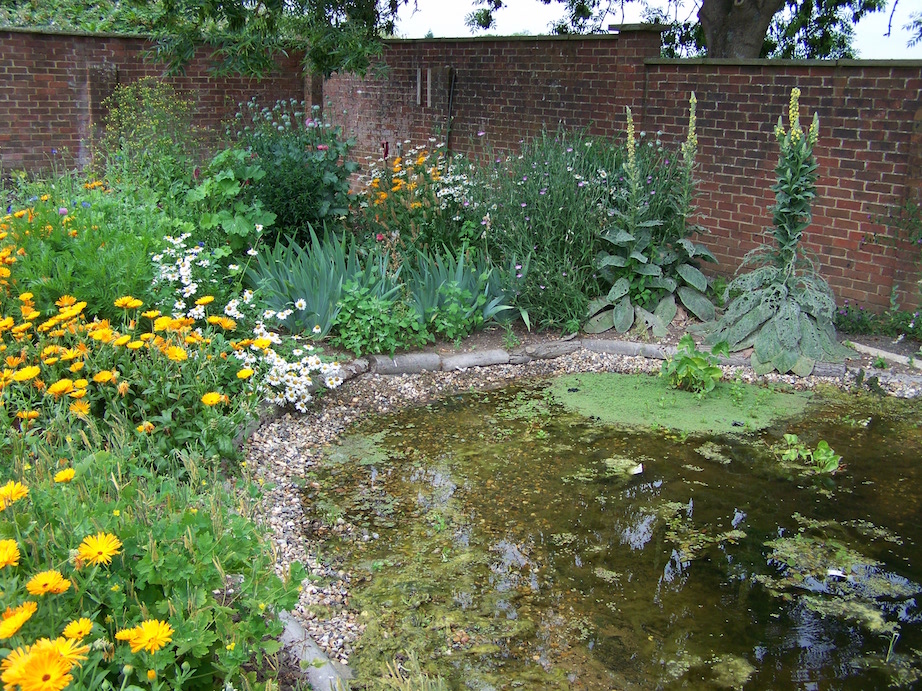
The pond has come on far more than I expected in it's first year, the flower and plants have bloomed with so much colour. I treated the blanket weed a few months ago so most of it has gone but then another weed appeared "Azolla" (water fern). This is very fast growing and can cover the whole of the pond stopping any light getting in. How did it got in there? the only thing I can think of is it was brought in by the ducks that visit the pond. We will never remove it but we can control it by netting it out. A few week ago Lesley, Pat and myself started do that and to our great surprise also pulled out Newt poles with every net of weed we pulled in, more than 50 in total. Pat was very carefully going through the weed as we netted it out to separate the young newts to release again in the pond. A very good year for breeding newts, we are already looking forward next spring to see how the frogs do. 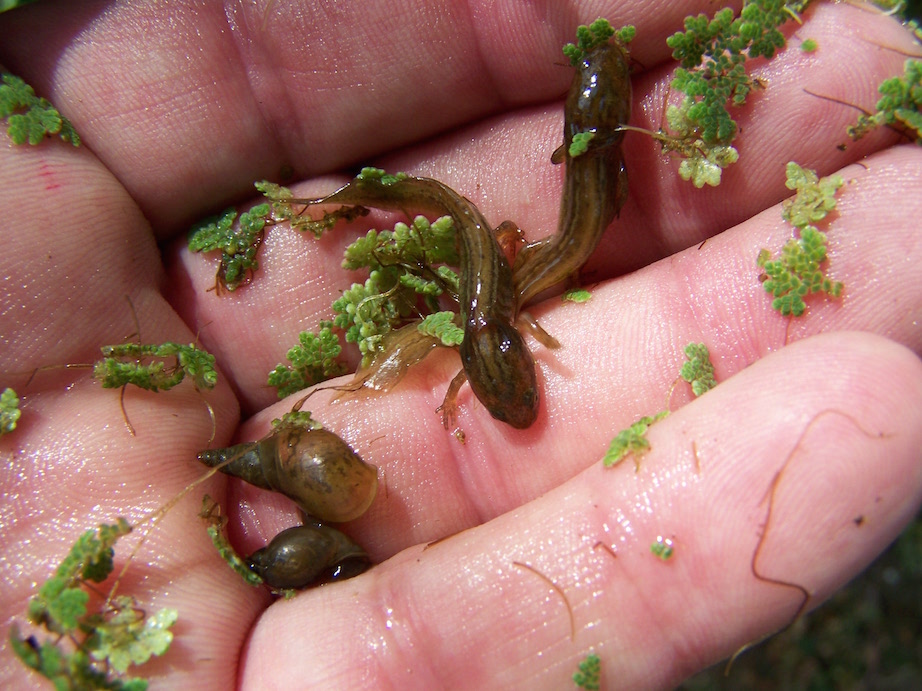
Tom's lavenders have started to flower, you must have a look over the next few weeks. They are alive with butterflies, honey bees and bumble bees. Around the back of the garden under the metal sheet, lots of Voles and shrews are around and even a few nice size grass snakes. See you all next month ..... Ed JUNE UPDATE June is now here and the garden is blooming. 
The pond still has a lot of blanket wood but in time that should settle down. Common blue damselfly seen at the pond and a lone Broad-Bodied Chaser hunting over the water. The garden around the pond is beginning to brighten up, in another few weeks it will be very colorful. I would just like to say to everyone that has helped with plants and useful information a big thanks for your help. The bird boxes may not have been as many as last year but there was bigger increase in broods with Blue and Great Tits, I have only found one robin's nest which reared 5 young.  Ray and myself were very lucky to see the mandarin ducklings leave the garden with their mum, there were between 10 and 12 of them.
Ray and myself were very lucky to see the mandarin ducklings leave the garden with their mum, there were between 10 and 12 of them. It was a shame but the Tawny Owls never came back this year, but again we did have a nest in one of the smaller owl boxes of YES..........Little Owls. When I checked the box there were 3 eggs, but she could had laid another 3 on top of that.Photo shows the last owlet before it left the box. Wonder what we will get next year, See you all in July. Enjoy the sunny weather ..... Ed MAY UPDATE Hello again, we have now moved into May and the garden's wildlife is in full swing. Last time I said only one Newt had been seen in the pond, a week later up to 12 could be seen.  On the left is a photo of one of our frogs, and on the right a common newt, but sadly no frog tadpoles this year but we should have a lot of Newt Tadpoles, also a big variety of water insects.
On the left is a photo of one of our frogs, and on the right a common newt, but sadly no frog tadpoles this year but we should have a lot of Newt Tadpoles, also a big variety of water insects.
Under the metal sheet there are a lot of Bank Voles which breed none stop, Common Toad of all sizes and 2 Water Shrews have been seen, they are black and very small. No Grass Snakes spotted yet which is a shame. The bird boxes are busy, mostly Blue and Great Tits, and I am happy to say the Robins are the first to hatch out; a family of 5 are doing well. In 2013 the Robins reared 23 chicks, unfortunately last year all of the chicks and eggs were taken by Magpies or Woodpeckers. So this year I put metal grills over the front of the boxes and it seems to have worked a treat. 
 Our prize bird is the Mandarin Duck, this is the second year she has nested in the garden, The eggs are due to hatch out in a few weeks and the mother will lead her brood to water, alas not our pond as it is too small.
Our prize bird is the Mandarin Duck, this is the second year she has nested in the garden, The eggs are due to hatch out in a few weeks and the mother will lead her brood to water, alas not our pond as it is too small.
If you are down at the garden you will notice that the bird feeders are empty now until October as the birds will find enough to eat around the garden. No new sightings of birds this month as I have been too busy to sit down and take notes. Enjoy the sunny weather ..... Ed APRIL UPDATE Hello again, Spring is here at last, today Easter Monday the weather is wonderful and the garden is alive with wildlife.  The pond is doing well with water insects and the plant life is starting to grow with this warm weather but alas no frogs and no more sightings of newts. The pond is quite large and deep so you never know what is really in there.
The pond is doing well with water insects and the plant life is starting to grow with this warm weather but alas no frogs and no more sightings of newts. The pond is quite large and deep so you never know what is really in there.
The metal sheeting at the back of the garden seems to be a bit more attentive with the smaller mammals, Bank Voles are starting to make their little nests and are lot more Common Shrews running around, also a lot of Common Toads can be found under there. The bird life is in full swing at the start of the breeding season, we checked the boxes for the first time yesterday and 11 show signs of being used. It is still early days and I'm hoping for a lot more. We now have a resident Cock Pheasant who has taken over the garden as his own with his 4 hen birds, he is very tame now and will feed out of my hands. 
Greenfinches have started coming to the feeders which is nice to see also chaffinches, one in particular, a male. Usually they don't like humans too close to them but this guy will fly over to me for his mealworms. He has scales or warts on his legs called "Bumblefoot", this seems to affects only Chaffinches or Bramblings. (see photos) and more information here Waiting to see the first Swallow fly low over the garden. 
MARCH UPDATE The garden has 44 nest boxes around it's area, the tit boxes are very busy at the moment with the birds going in and out looking for a good nest site, (mostly Blue Tits) so I am hoping it is going to be a good year.  The wildlife corridor has now been cleaned up for the start of Spring. This was developed 4 years ago so a lot of the shrubs and plants now re-seed themselves and the area looks very colourful in the Summer; It is a big attraction for the insect world as well as bird life. There is a bird table and feeding station along the corridor as well as a bird bath.
The wildlife corridor has now been cleaned up for the start of Spring. This was developed 4 years ago so a lot of the shrubs and plants now re-seed themselves and the area looks very colourful in the Summer; It is a big attraction for the insect world as well as bird life. There is a bird table and feeding station along the corridor as well as a bird bath.
The pond is still very young, it was not planted out until last October (2014), a bit late but hopefully it will bloom by the time Summer comes. There is plenty of insect life swimming around already, for example Boatman, Skaters and Whirligig Beetle. No frogs have been seen yet but a Smooth Newt was found in the pond by Carolyn today (11th March)  On the rear wall as you come into the garden are some nesting sites for Solitary Bees, again these have not been up long so it will take a bit of time to build up.
On the rear wall as you come into the garden are some nesting sites for Solitary Bees, again these have not been up long so it will take a bit of time to build up.
At the rear of the garden on the other side of the wall is another wildlife area where we have put metal sheets down (10 in all) for cover and nesting for small mammals, insects, amphibians and reptiles. Bank voles do well there (good for the Owls) you will also find shrews, toads an the odd grass-snake. |
Sighted around the garden
Buzzards (up to 10 in one sighting) Fieldfares Jays Kestrels Mallard Duck Mandarin Duck Red Kites (up to 3) Redwings Rook Sparrowhawks Wood-pigeon |
|
Sighted in the garden
Blackbird Blue Tits Chaffinch Coal Tits Collard Dove Crow Dunnock Goldfinch Great Spotted Woodpecker Great Tits Greenfinch Jackdaw Jay Long-Tailed Tits Magpie a pair of Mallard Ducks landed in the pond on the 17th this week Nuthatch Pheasant Ring Necked Parakeet Song Thrush Starling Wood Pigeon Wren |
|
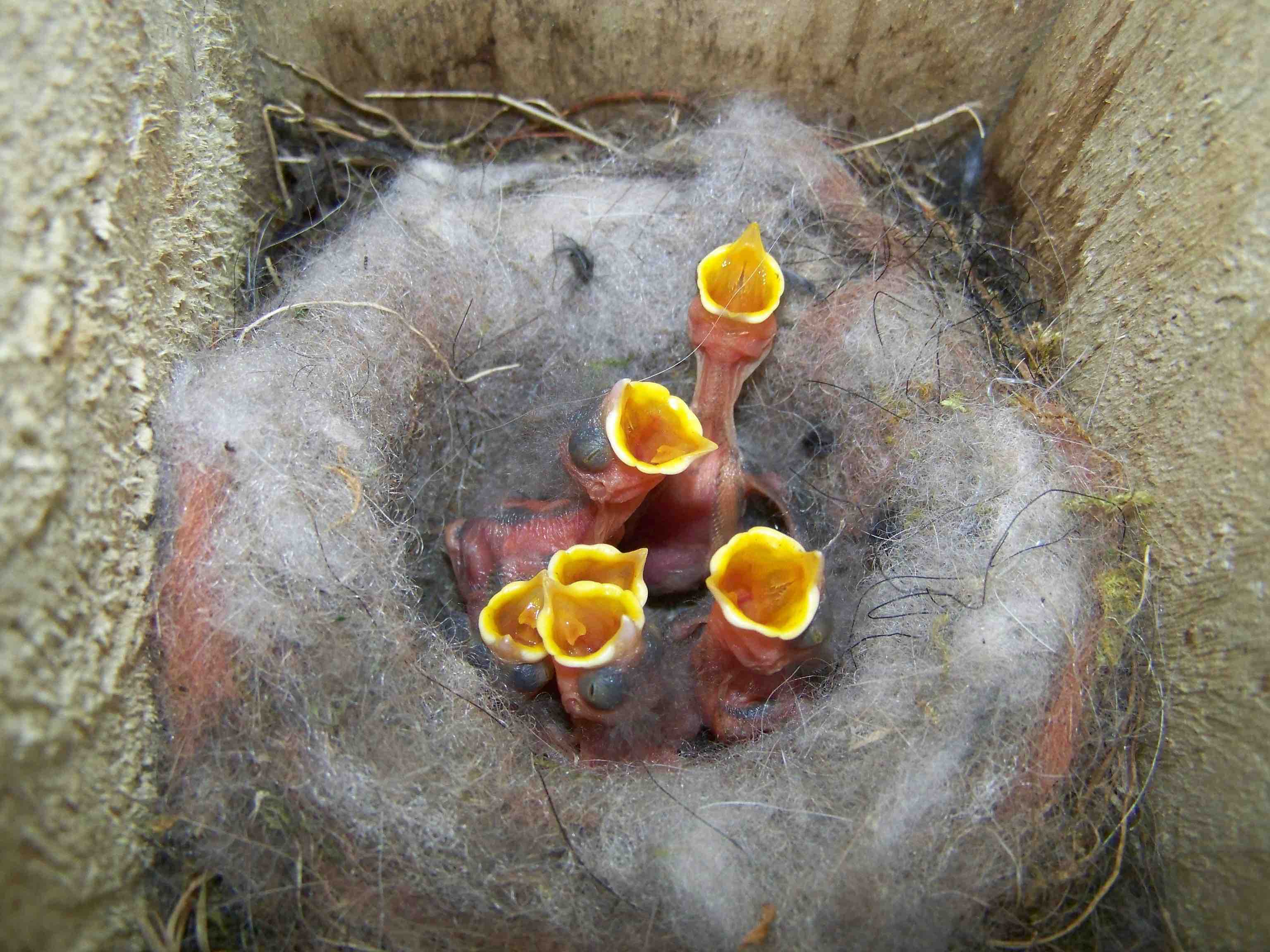
| |
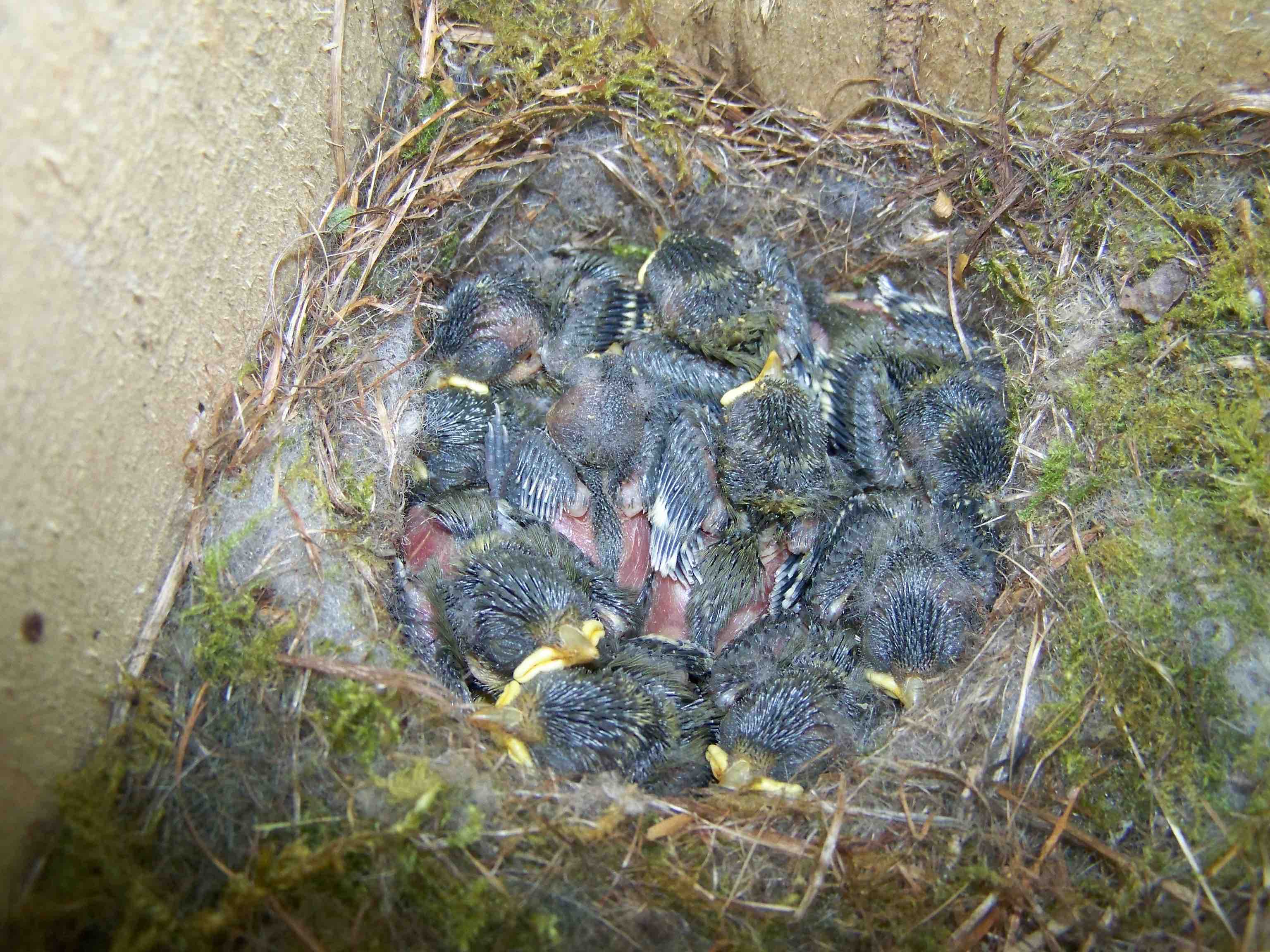
| |
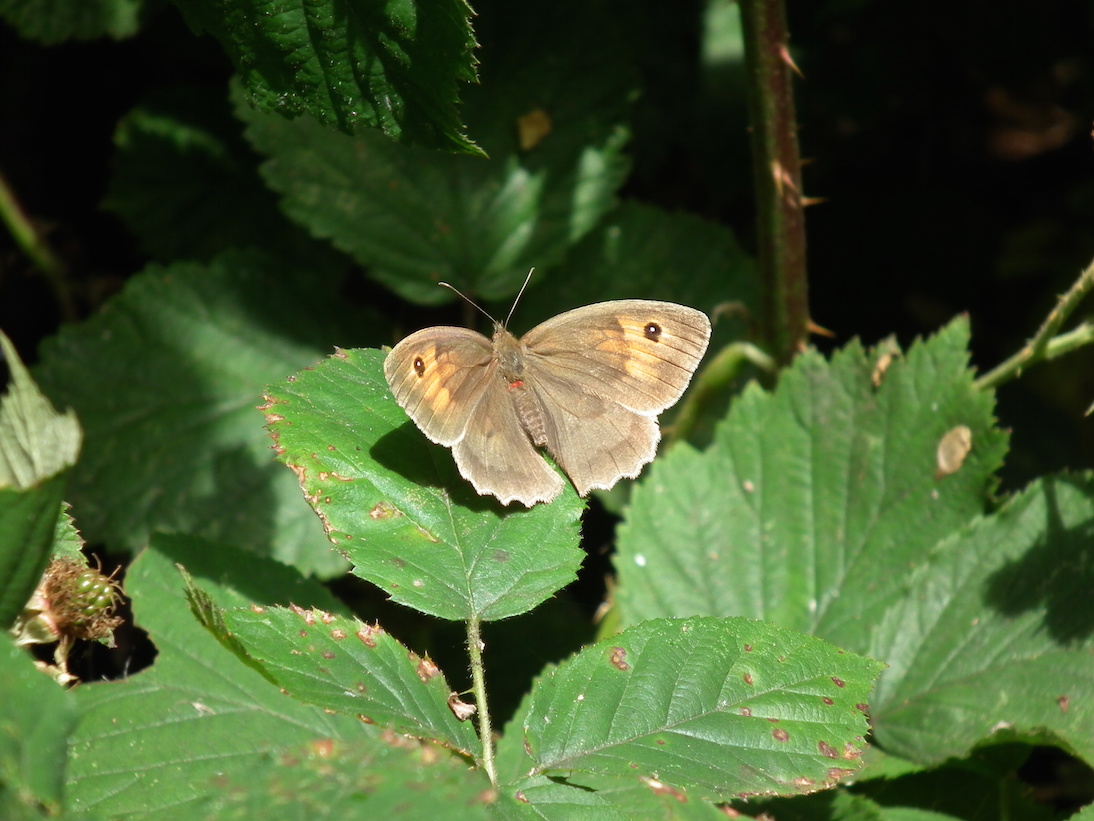
| |
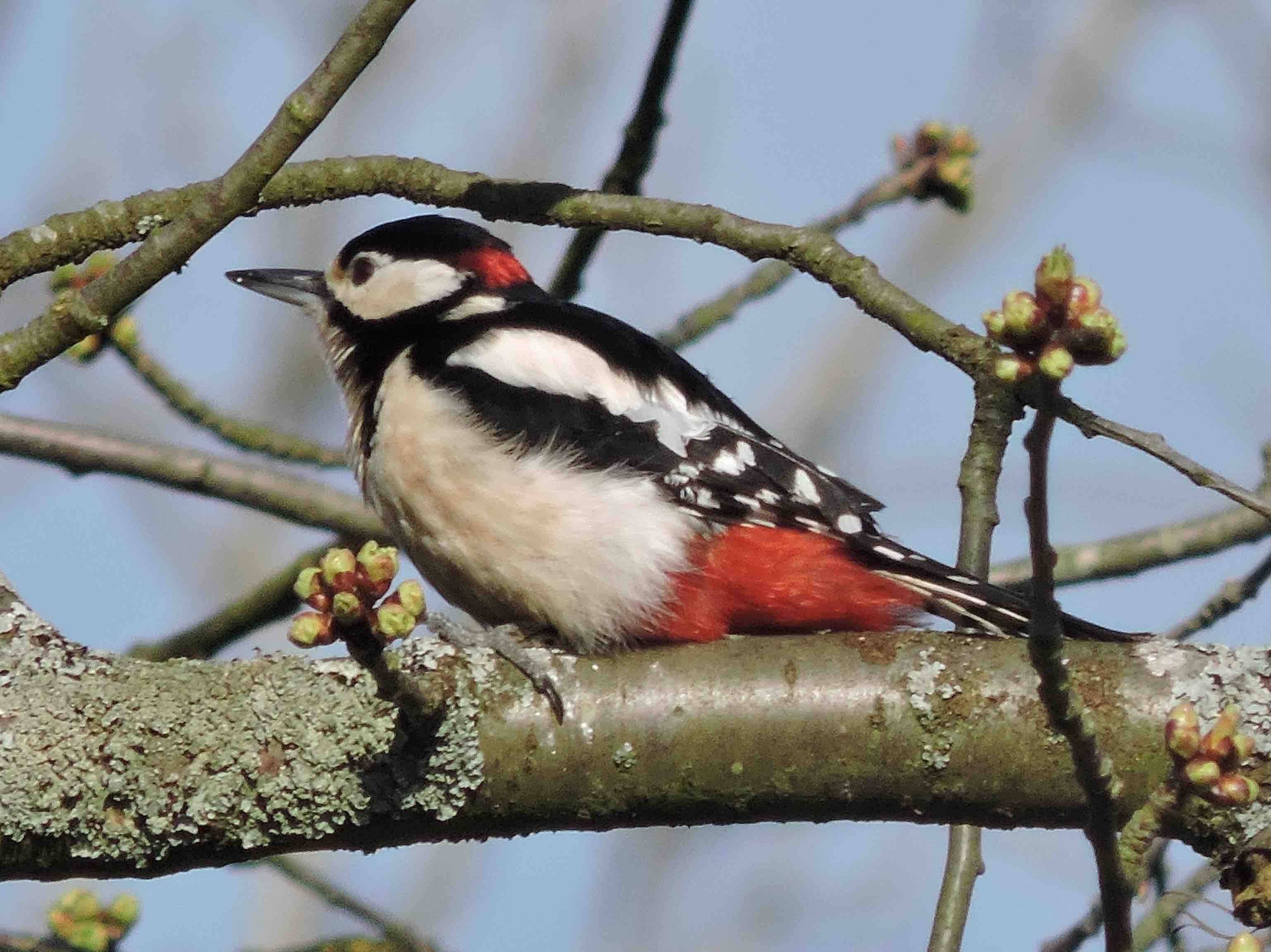
| |
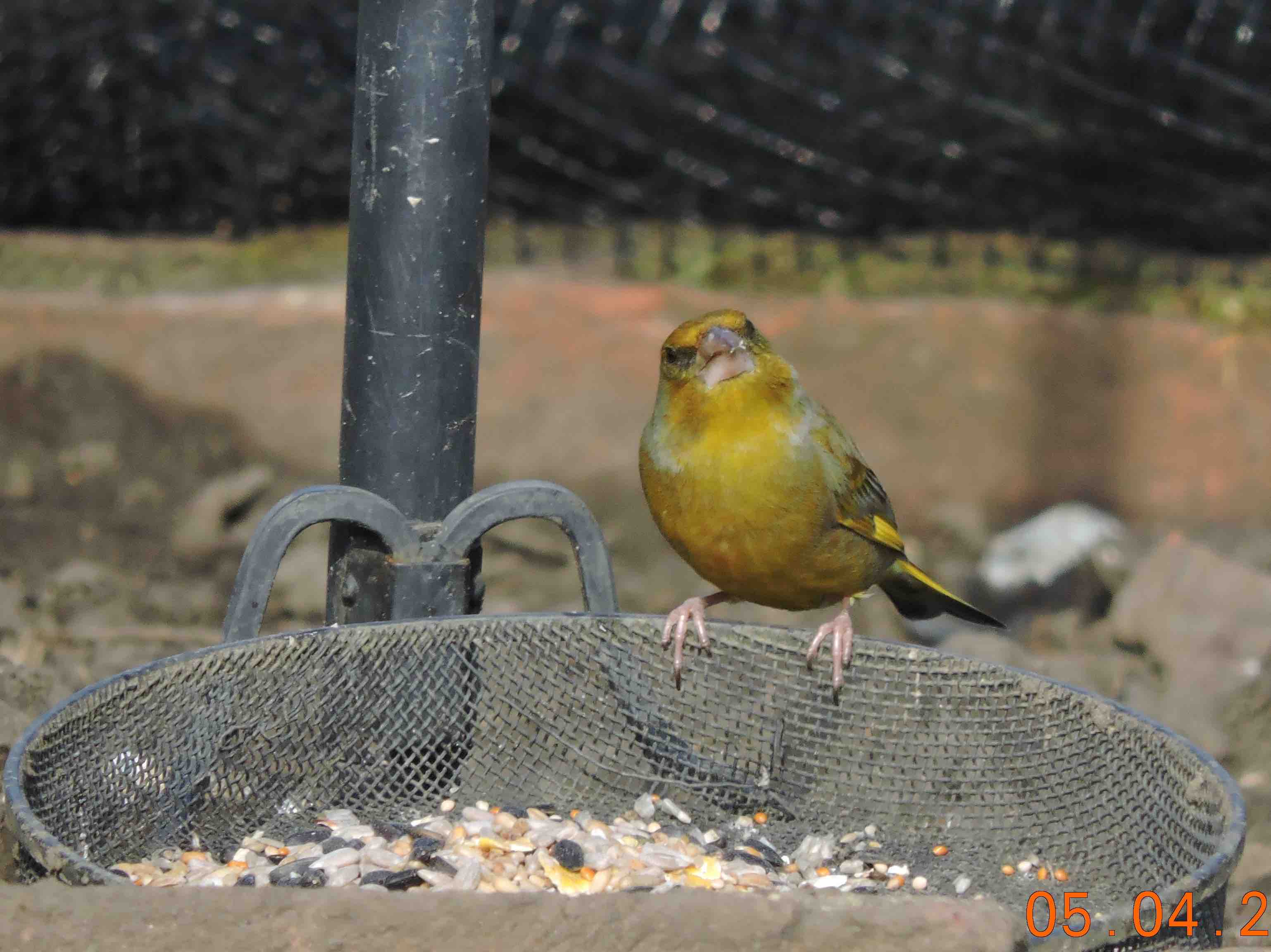
| |
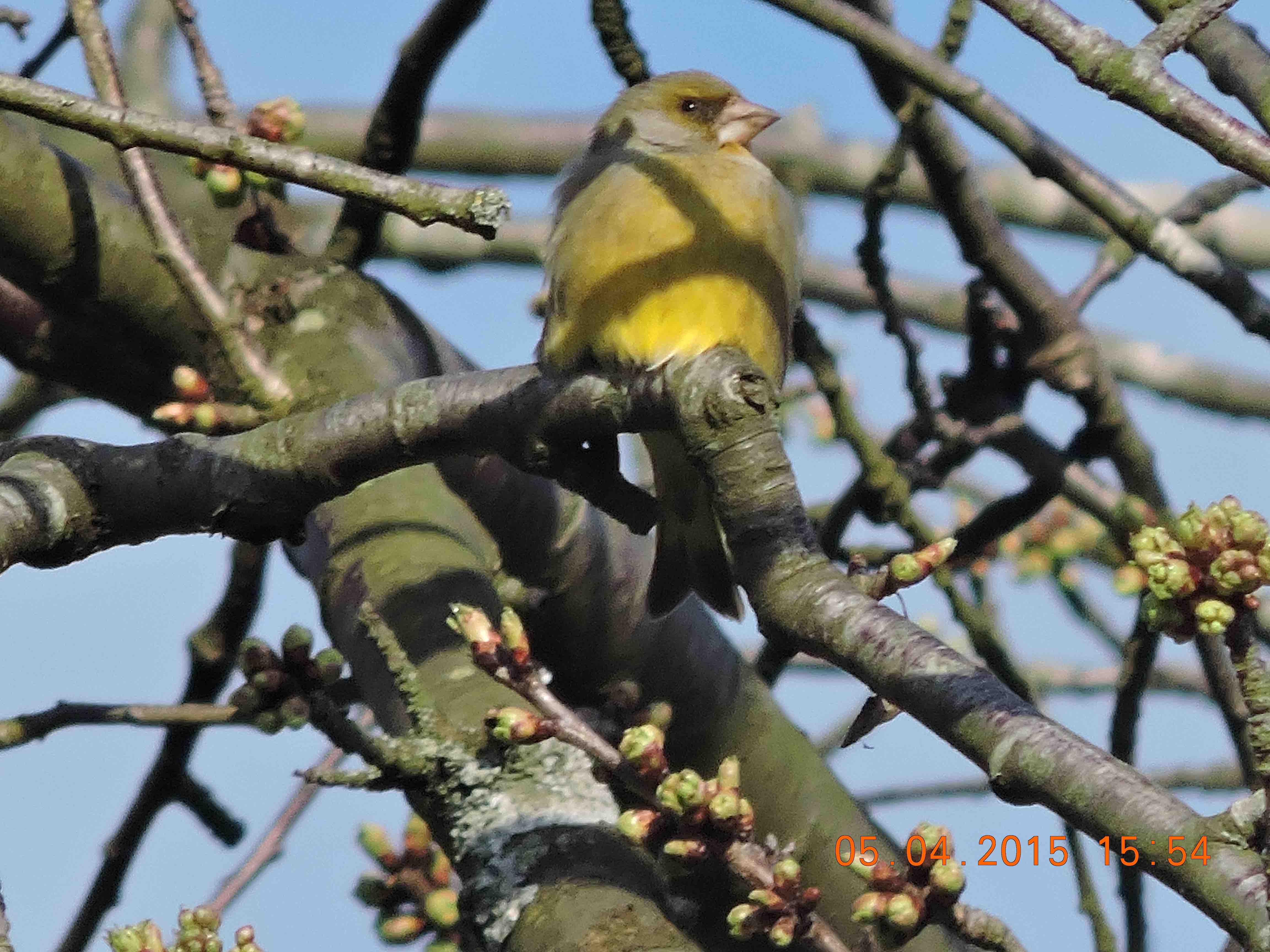
|
| FIND US | CONTACT US | |
|
Grace & Flavour CIC The Walled Garden Dene Place Ripley Lane West Horsley, Surrey KT24 6JW email: mail@graceandflavour.org 
|
|
|